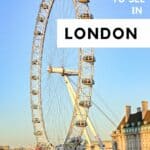What is London famous for? Pull up a seat and get comfy as we have a lot to cover. Here are fifty of so reasons why you should visit London.
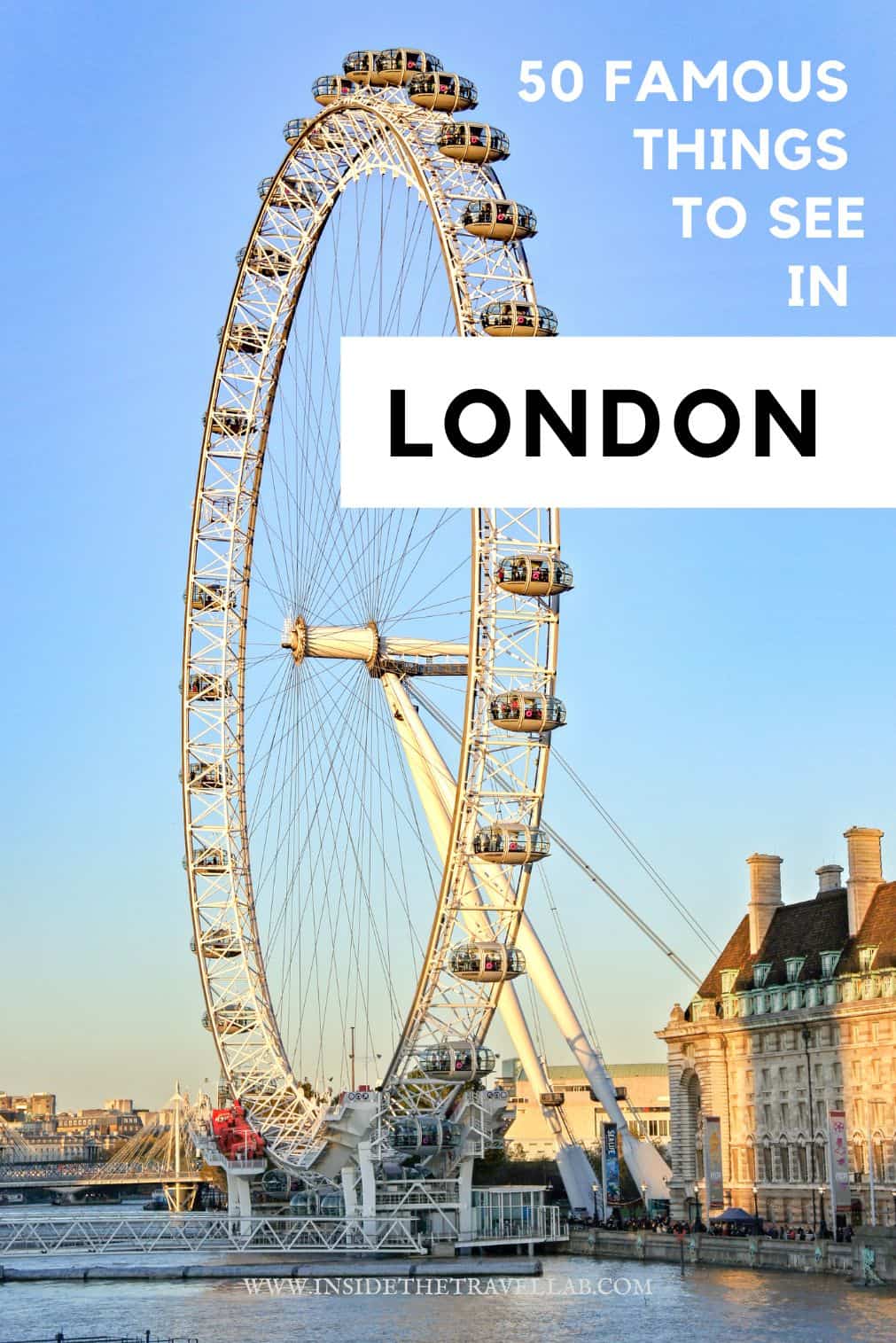
Why Visit London?
London is one of the most exciting cities in the world. And that’s not just because I was born there. London has history, fashion, science, politics, design and a whole lot more.
And if you’re planning a longer trip to London then it may be best to think beyond hotels. Check out these serviced apartments in London to find a better long term solution.
50 Things London is Famous For
Let’s start with all those buildings.
Famous Monuments in London
Famous for so many things, London probably excels itself with famous landmarks. How many of these famous buildings do you already know?
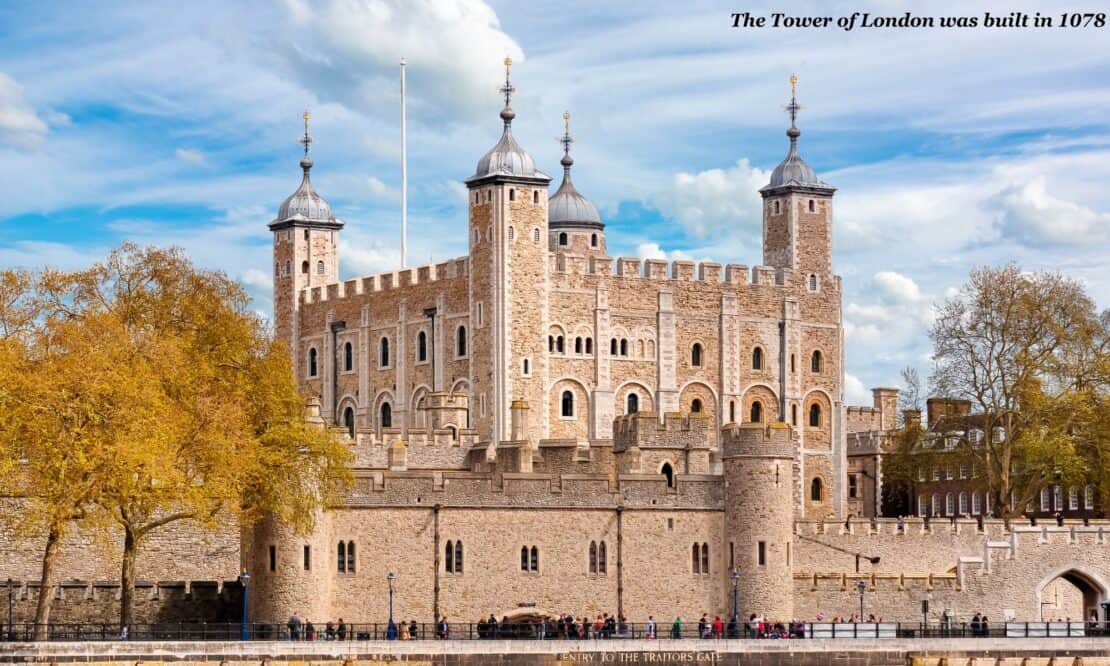
The Tower of London
The Tower of London stands proudly on the banks of the River Thames, embodying nearly a millennium of British history. Built by William the Conqueror in 1078, this iconic structure has served as a royal palace, prison, and treasury.
It’s here that Anne Boleyn was imprisoned and Lady Jane Grey executed. The Tower is also home to the dazzling Crown Jewels, including the Imperial State Crown and the Sovereign’s Sceptre with Cross. Its White Tower, a symbol of Norman military strength bursts with arms and armour, including that of the sizeable Henry VIII.
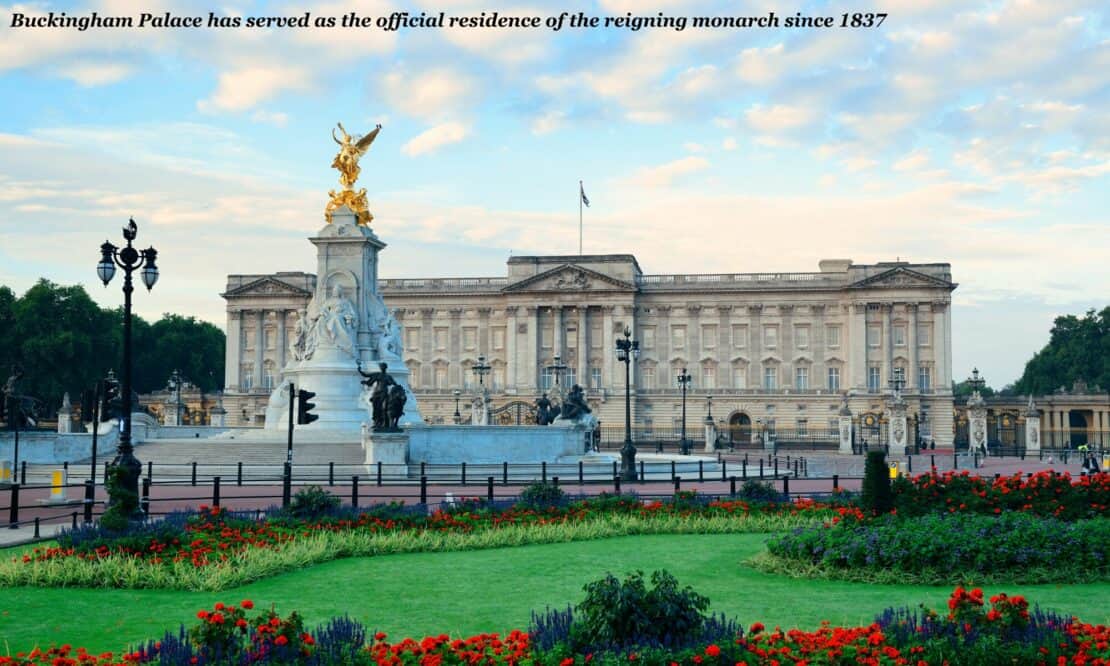
Buckingham Palace, The Royal Family & The Changing of the Guard
Serving as the official residence of the reigning monarch since Queen Victoria’s occupancy in 1837, the palace is not only a working royal residence but also a focal point for national celebrations and events. The ceremonial Changing of the Guard is a time-honoured tradition that occurs outside the palace, is a spectacle of military precision and pageantry. This centuries-old ceremony involves the Old Guard handing over responsibility for protecting the palace to the New Guard. Accompanied by stirring music and precise drill movements, the Changing of the Guard attracts crowds from around the world.
It’s free to stand outside and peer in, or you can book in advance for one of a very few limited tours of the State Rooms inside. I was surprised at how beautiful they are – and the guided tour gives just the right amount of historical information to put things into place while still keeping the trip visiting. Who knows? You may even see the royal family.
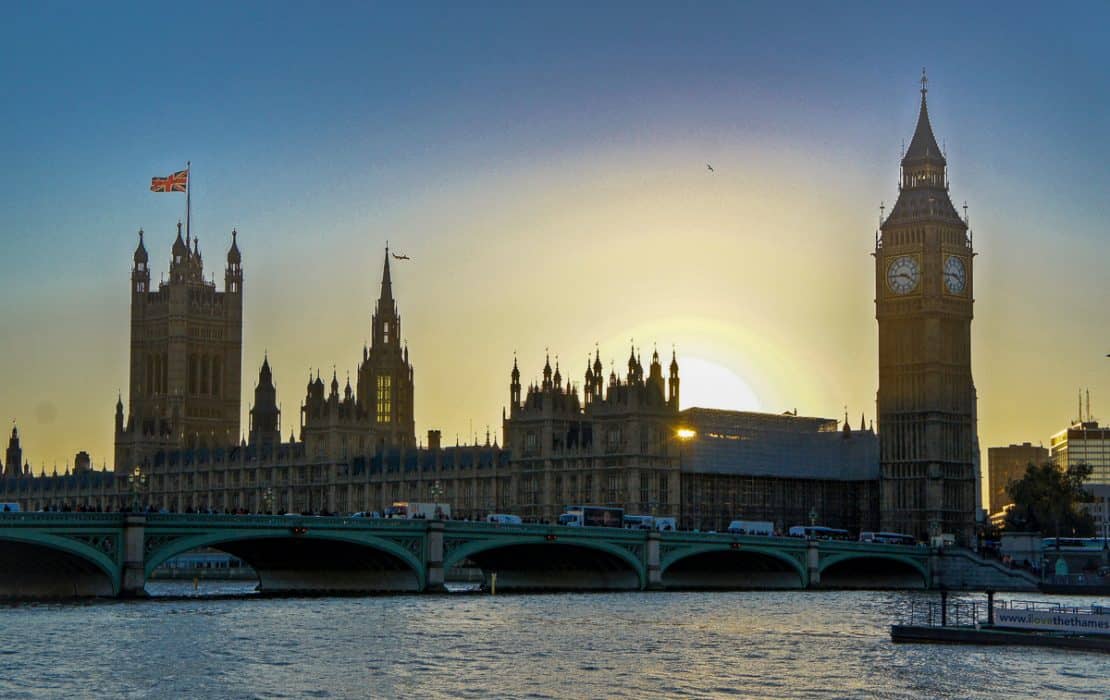
Big Ben & The Houses of Parliament
The Palace of Westminster and the Big Ben collectively form one of the most recognisable and cherished landmarks in London. Overlooking the River Thames, the Parliament complex is a masterpiece of Victorian Gothic architecture, designed by Sir Charles Barry and Augustus Pugin. Construction of the palace began in 1837 and was completed in 1870.
Big Ben, officially known as the Elizabeth Tower, stands tall within the palace precincts, its resounding chimes echoing through London. While often used colloquially to refer to the clock or the entire tower, Big Ben specifically denotes the 13-ton Great Bell housed within. The parliamentary sessions and debates that take place within the grand halls contribute to the city’s political history, for better and for worse.
You can visit but you need to book in advance and times are limited. But, of course, you can stand and look at the Clock Tower for free.
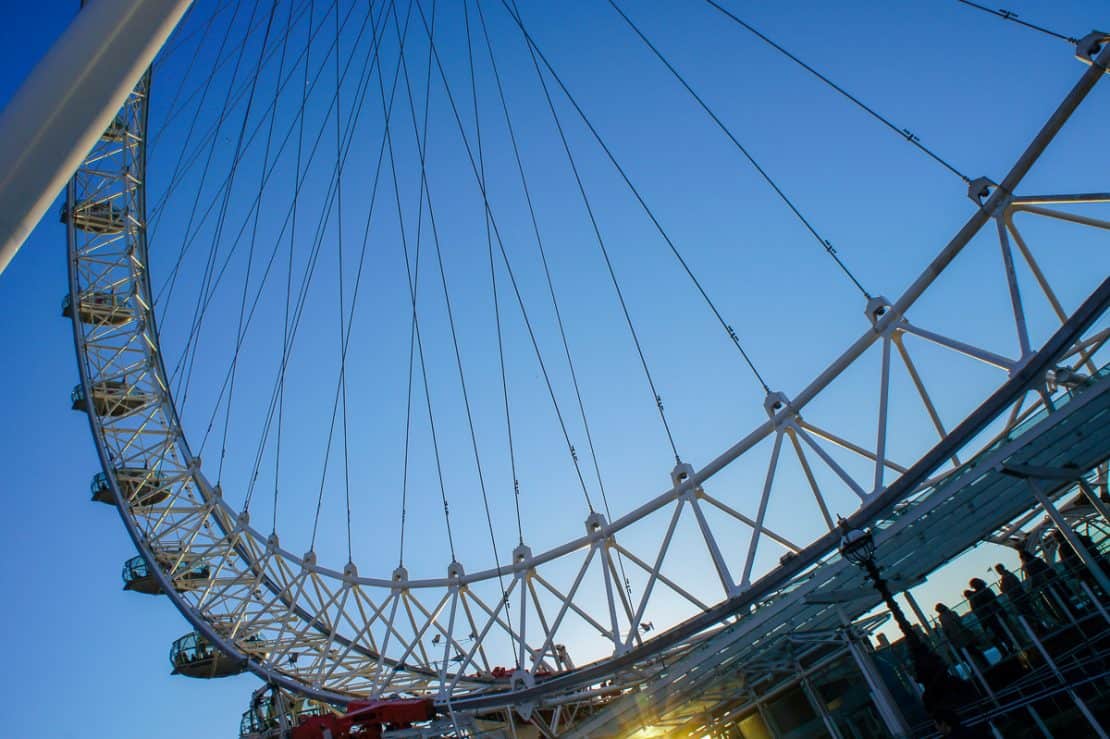
The London Eye
Just across from Big Ben on the South Bank of the River Thames is the London Eye, offering great views of the city’s skyline. Erected in 2000 to celebrate the new millennium, this colossal observation wheel has become an integral part of London’s landscape. Standing at 135 meters tall, it was once the world’s tallest observation wheel.
The London Eye’s futuristic capsules provide visitors with a 30-minute, slow-rotating journey, showcasing landmarks such as St. Paul’s Cathedral, the Shard, and Buckingham Palace. Lit up spectacularly at night, this observation wheel on the south bank is one of the most easily recognised landmarks in London as you fly in to Heathrow.
Westminster Abbey
Also within easy walking distance is Westminster Abbey, a Gothic masterpiece that has witnessed coronations, royal weddings, and state funerals, including the wedding, coronation and funeral of Queen Elizabeth II.
Its intricate architecture, adorned with flying buttresses and stunning stained glass windows, captivates visitors with a sense of reverence. The Poets’ Corner memorialises literary giants such as William Shakespeare and Charles Dickens.
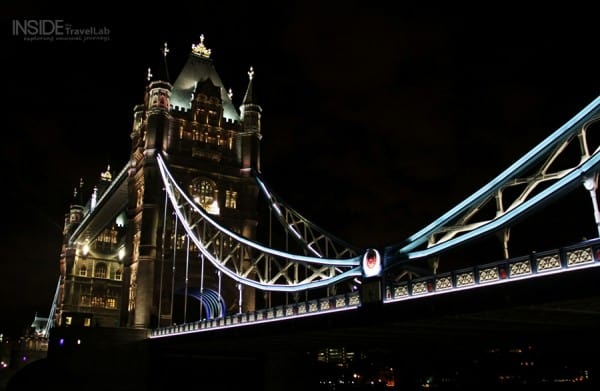
Tower Bridge
Tower Bridge (not to be confused with London Bridge) spans the River Thames with its majestic twin towers and intricate Victorian Gothic design. Completed in 1894, the bridge quickly became a defining feature of the city’s skyline. Its bascules, or drawbridges, allow large vessels to pass through, which just looks plain odd in such a behemoth of a bridge.
High-level walkways connect the towers and the Tower Bridge Exhibition, housed in the northern tower, offers insights into the bridge’s history and construction.
Illuminated by thousands of LED lights at night, I always love the view, whatever time I go there.
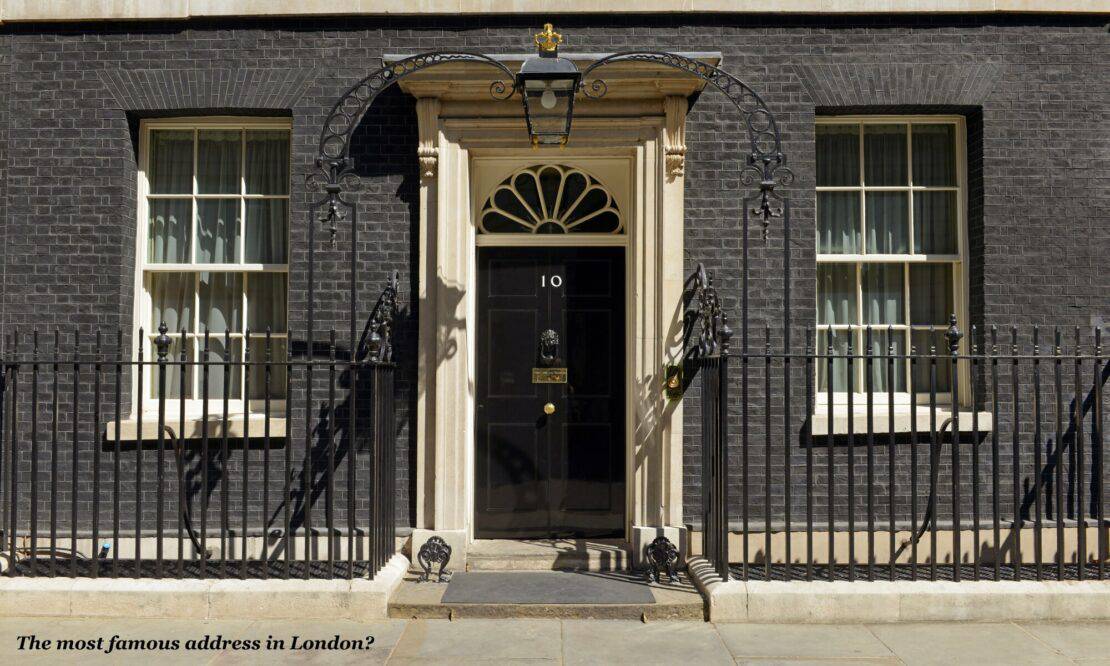
10 Downing Street
10 Downing Street is a discreet yet famous address in the heart of London, serving as the official residence and executive office of the Prime Minister of the United Kingdom. Nestled in the Whitehall area, this unassuming black door has been the nerve centre of British governance since Sir Robert Walpole, making it one of the world’s oldest continuously inhabited government residences.
Not that you can get that close to it, of course. You can peer through the railings at the end of Downing Street and take your chances on seeing one of the country’s politicians drive past.
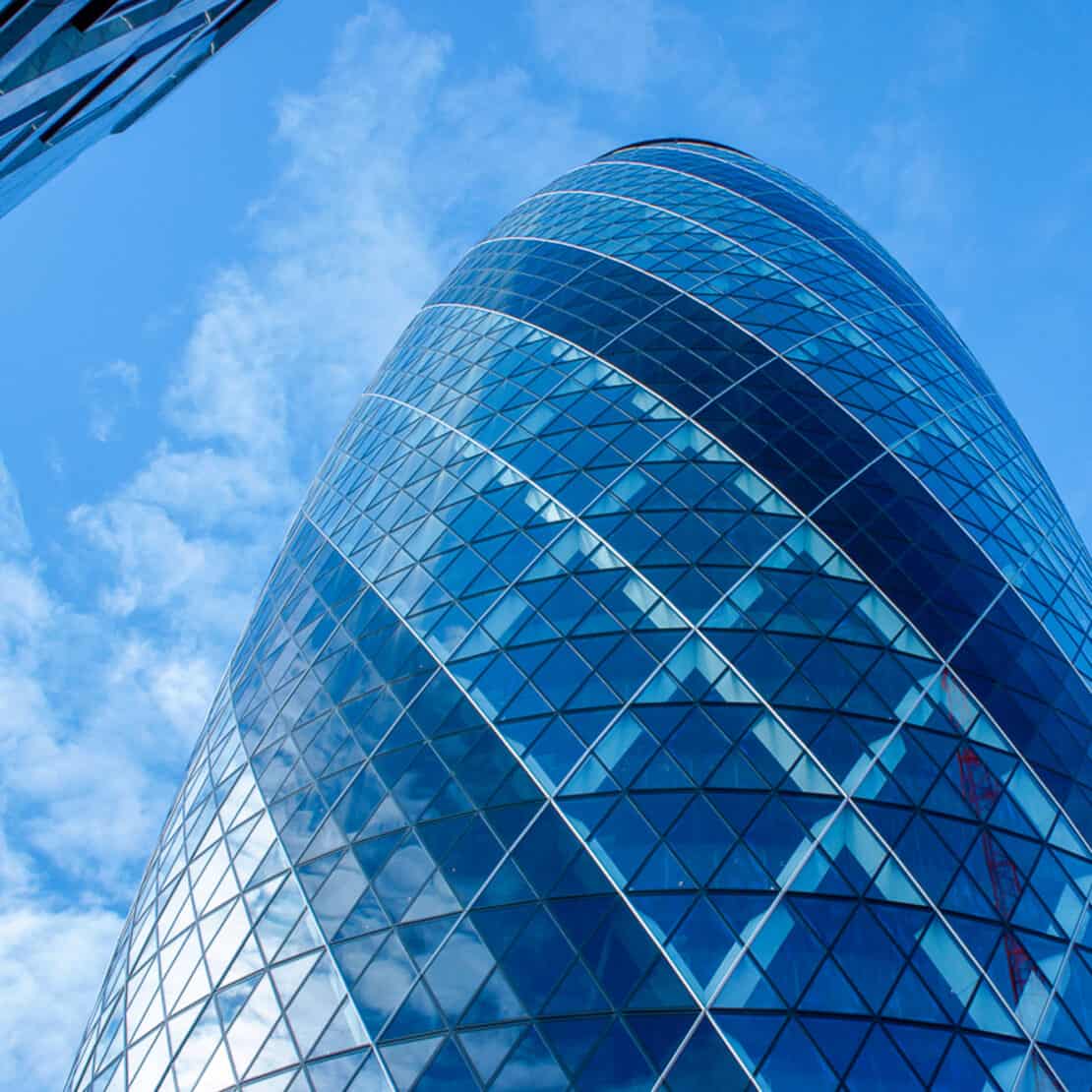
The Gherkin
The Gherkin, officially known as 30 St Mary Axe pierces the city skyline with its distinctive, cylindrical shape, earning itself its nickname. Designed by Sir Norman Foster and completed in 2003, the building itself houses offices and restaurants in the financial district. The Gherkin’s energy-efficient design, featuring a glass façade that maximizes natural light and ventilation, reflects London’s commitment to sustainable architecture. And its sleek and futuristic appearance makes it fun.
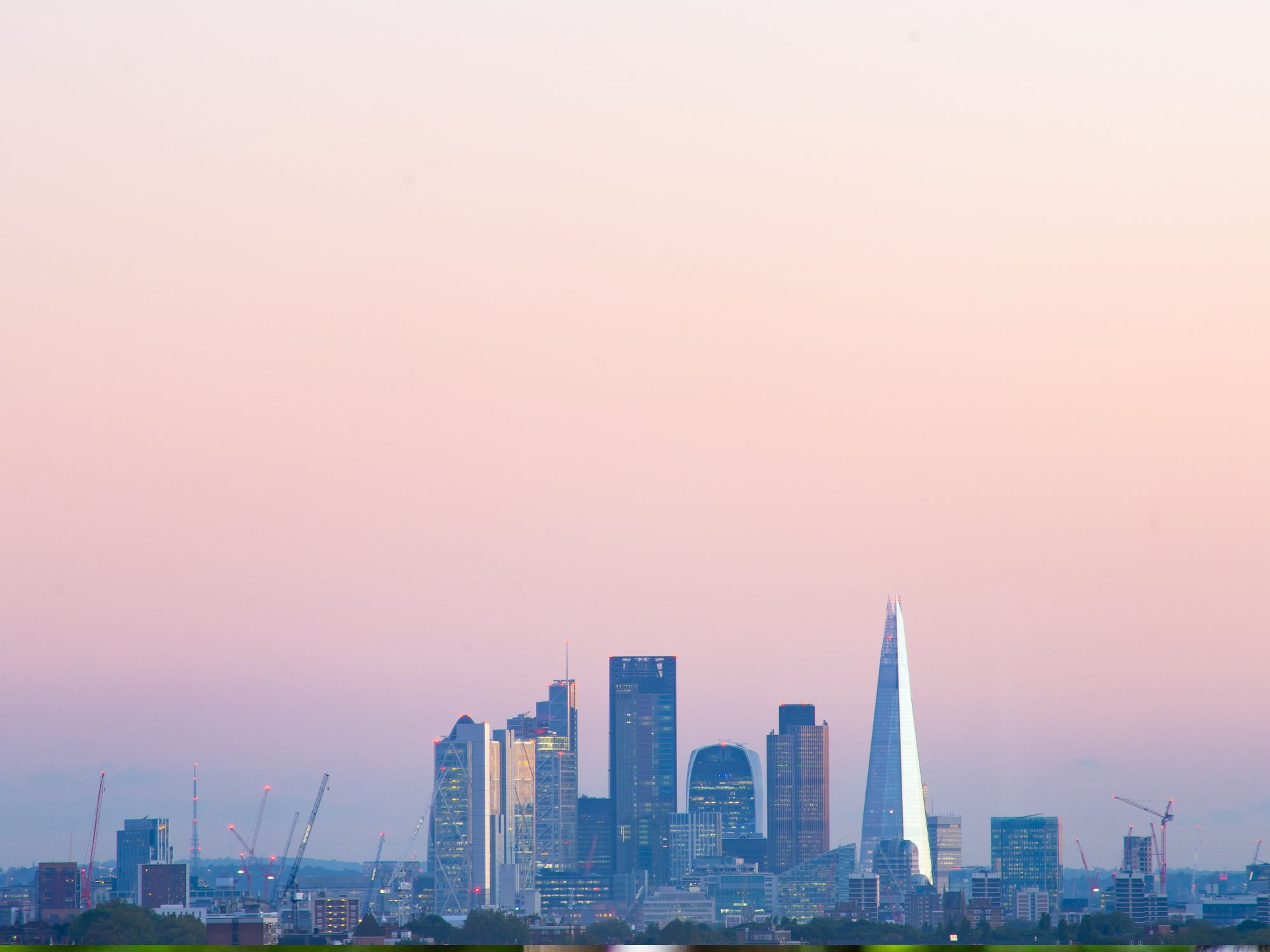
The Walkie-Talkie
Speaking of fun, 20 Fenchurch Street, colloquially known as the Walkie Talkie building, also stands out on the streets of London. Designed by architect Rafael Viñoly, this skyscraper is characterised by its unique, concave shape, which widens as it rises, culminating in a rooftop terrace known as the Sky Garden. Completed in 2014, the Sky Garden is London’s highest public garden (you can go up there for free) with staggering views of the city and the River Thames.
It’s one of my favourite things to do as part of a London itinerary.
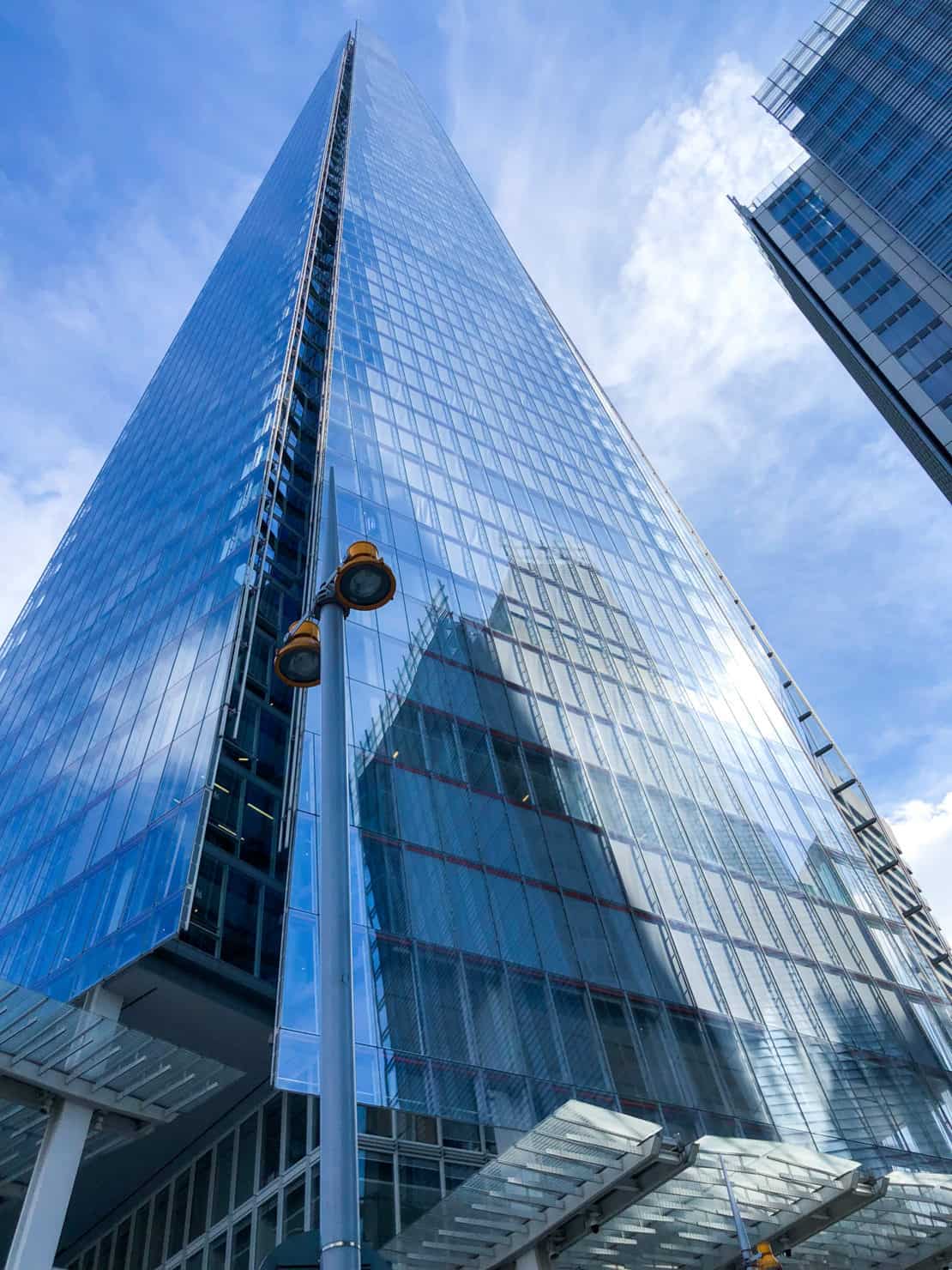
The Shard
Standing at a soaring height of 310 meters, The Shard is the tallest building in the United Kingdom and Western Europe. Renowned architect Renzo Piano designed this stand-out skyscraper, which was completed in 2012. The Shard’s crystalline structure, resembling a gleaming shard of glass, reflects the city’s dynamic spirit, according to the less cynical and jaded in London.
The building houses a mix of offices, restaurants, a luxury hotel, and, on its upper floors, offers an observation deck providing panoramic views of London.
But like it or loathe it, it’s an unmistakeable part of the London skyline.
The Millennium Dome
The Millennium Dome, now known as The O2 Arena lives as a kind of flat pancake near the riverbed. Originally constructed to mark the turn of the millennium in the year 2000, the dome was envisioned as a space for the Millennium Experience exhibition. However, it faced mixed reviews (which is Brit speak for people hating it) and challenges in finding a permanent purpose.
In 2007, it was transformed into The O2 Arena, a world-class entertainment venue. Designed by architect Richard Rogers, the dome’s distinctive white canopy shelters a concert arena, cinema, exhibition spaces, restaurants, and bars.
And all the old grumbling is forgotten. Sort of.
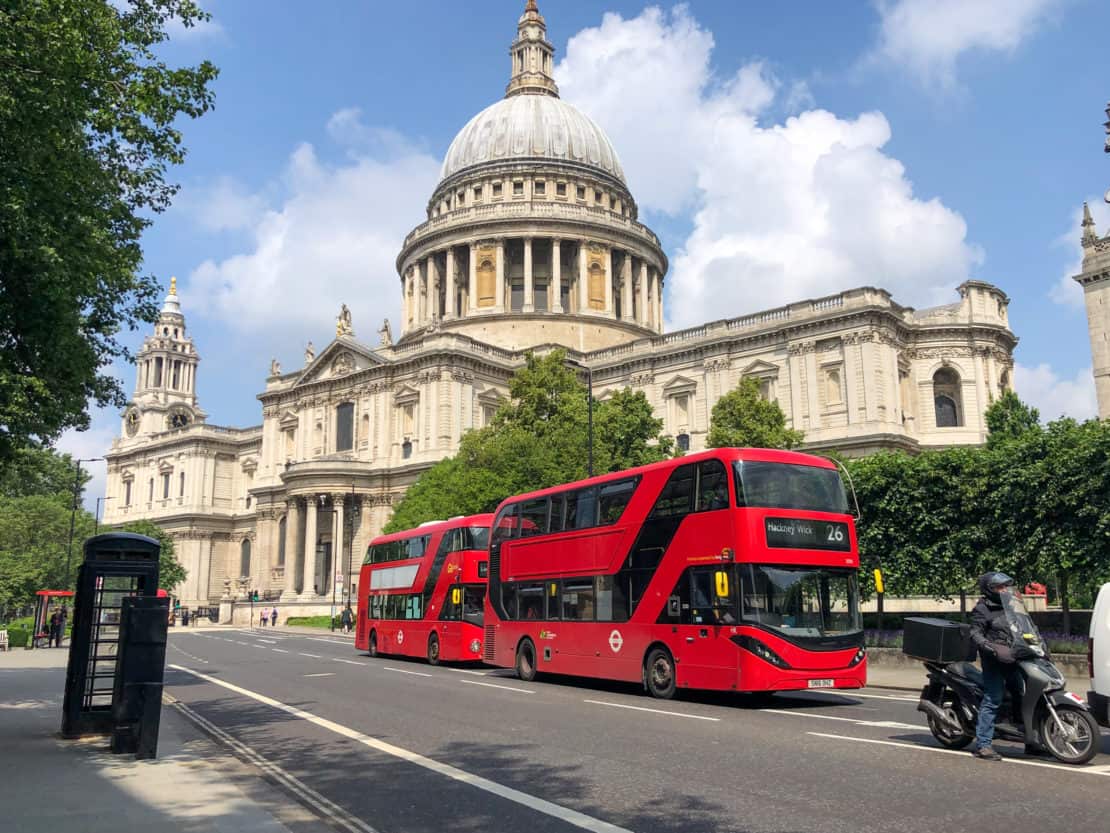
St Paul’s
Designed by Sir Christopher Wren, St Paul’s stands inside the actual City of London close to the Bank of England, as shown in the Feed the Birds section of Mary Poppins.
Completed in 1710, this iconic cathedral replaced its predecessor destroyed in the Great Fire of London in 1666. Its majestic dome, flanked by Baroque-style towers, was once the highest point in London.
St. Paul’s has played a pivotal role in British history, hosting important events such as the state funeral of Sir Winston Churchill. The interior has awe-inspiring features, including the Whispering Gallery and the intricate mosaics of the dome’s interior. Surviving the Blitz during World War II, St. Paul’s remains a symbol of resilience and national identity.
Famous Sport Connections in London
You will find that London is home to an awful lot of sport…
Wembley: Home of Football
Wembley, situated in northwest London, holds a special place in the city’s identity as the home to Wembley Stadium. The stadium, often referred to as the “Home of Football,” is a symbol of sporting excellence and has hosted historic events, including the FA Cup Final and numerous memorable concerts. The original Wembley Stadium, famous for its twin towers, was replaced by the state-of-the-art Wembley Stadium in 2007, with its characteristic arch.

Wimbledon: Home of Tennis
Wimbledon, a district in southwest London, is internationally known for hosting the prestigious Wimbledon Championships, one of the four Grand Slam tennis tournaments. The All England Lawn Tennis and Croquet Club, where the Championships take place, stands as a hallowed ground for tennis enthusiasts, with the iconic Centre Court and its retractable roof adding a modern touch to the historic venue.
Lords: Home of Cricket
Lords Cricket Ground, often referred to as the “Home of Cricket,” is a hallowed venue located in St John’s Wood, North West London. Steeped in history and tradition, Lords stands as the epicenter of the sport, hosting international matches, historic moments, and serving as a revered pilgrimage site for cricket enthusiasts worldwide.
Founded in 1814, Lords is the world’s oldest cricket ground in continuous use. The distinctive Victorian Pavilion, with its sloping red roof, adds to the ground’s timeless charm. The Long Room within the Pavilion is a revered space, adorned with portraits of cricket legends and hosting players and dignitaries during matches.
The famous “Honours Boards” in the Pavilion display the names of cricketers who have achieved exceptional performances, contributing to the ground’s rich legacy. The aura of Lords is further enhanced by the Victorian gas lamps that illuminate the field during evening matches.
The slope on the Lords pitch, a unique characteristic of the ground, has added complexity to the game and has been witness to legendary battles between bat and ball.
Lords is also the headquarters of the Marylebone Cricket Club (MCC), one of the oldest cricket clubs in the world. The MCC Museum within the ground houses a collection of cricket memorabilia, including the original Ashes urn, making it a treasure trove for cricket history enthusiasts.
Twickenham: Home of Rugby
Twickenham is best known as the “Home of English Rugby,” with Twickenham Stadium, the largest dedicated rugby union venue in the world.
Famous Green Spaces in London
One of the things that London does really well as a city is its parks. Sunshine, not so much. But parks. For a city. It is fabulous. Acres of green grass. Frolicking deer. Shady oaks and plenty of history. To be honest, it’s hard to pick my favourites. But these are probably the most famous London parks.
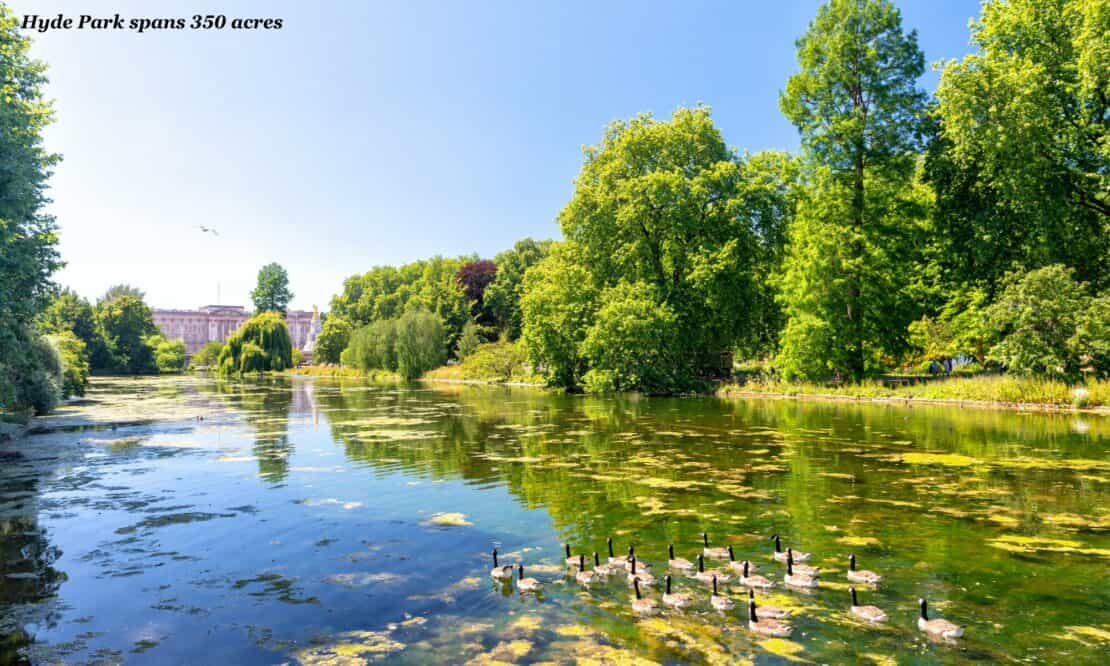
Hyde Park
Hyde Park is not just a park but a sprawling cultural and recreational landscape that is a part of London’s soul. It’s arguably London’s most famous park, although it’s up against some stiff competition.
Established in 1637, Hyde Park spans 350 acres and is one of the Royal Parks of London. Its vast green expanses, punctuated by serene lakes and historic monuments, provide a refuge from the hustle and bustle outside.
The Serpentine, a meandering lake within the park, offers opportunities for boating and swimming. September sees “Proms in the Park” – an open-air concert where you can sing Rule Brittania.
Look out for the Diana, Princess of Wales Memorial Fountain, and if you have children, make sure to head to the play centre which stands in her honour.
But my favourite spot? Speaker’s Corner, where traditionally you could speak your mind even in the days when people could have their heads chopped off. Today, you’ll usually find at least a handful people stood on soapboxes, addressing the world.
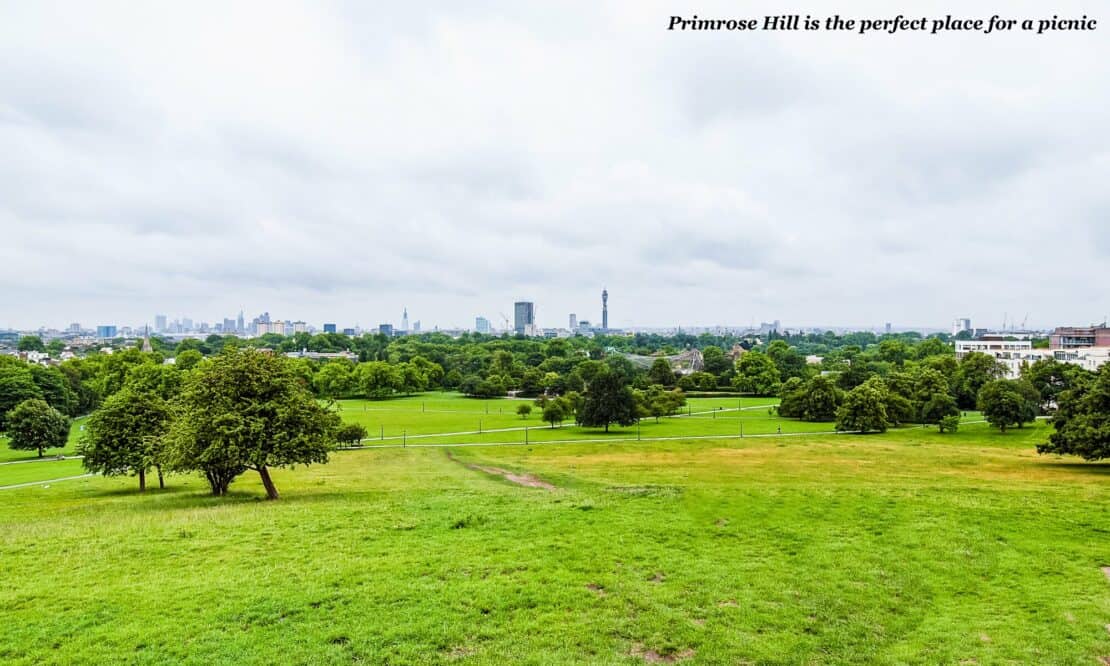
Primrose Hill
Primrose Hill is another of my favourite parts of London, for its out of the way feel and surprise views of the sprawling city. Primrose Hill, a charming and elevated green space in North London, provides a picturesque escape and panoramic views of the city skyline. As part of Regent’s Park, Primrose Hill has been a popular retreat since the 19th century with landscaped paths, open meadows, and old-fashioned lampposts.
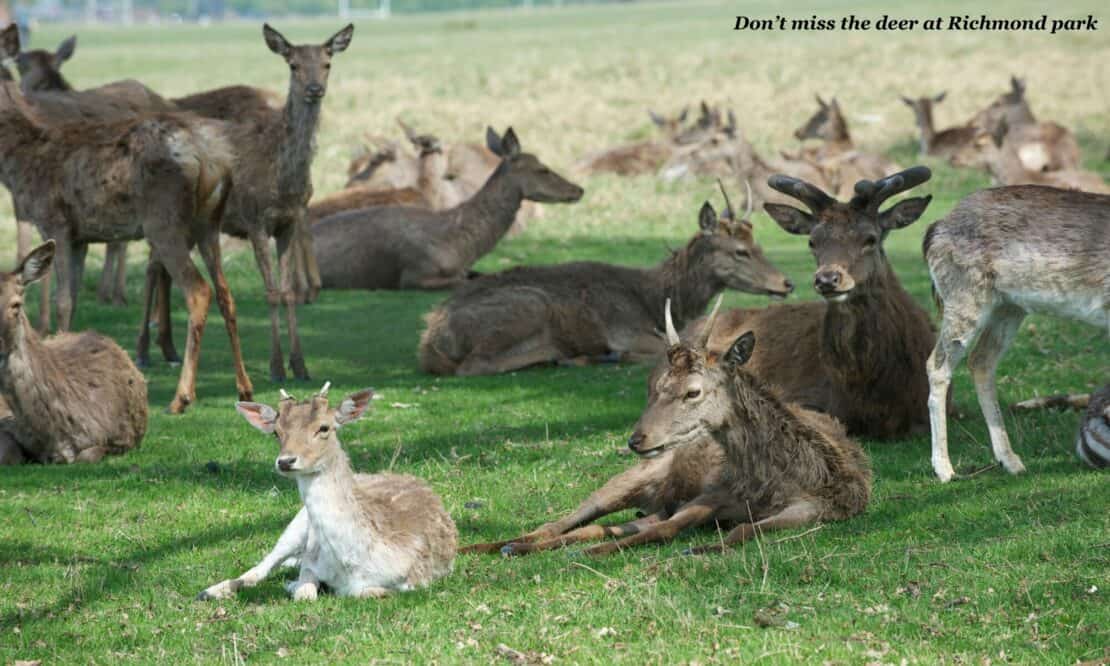
Richmond Park
Richmond Park is huge. Established as a royal hunting ground by Charles I in the 17th century, Richmond Park is the largest of London’s Royal Parks, covering over 2,500 acres. The park’s landscape includes woodlands, grasslands, ponds, and the Isabella Plantation, a beautifully landscaped woodland garden. One of its most distinctive features is the roaming herds of deer. The park’s Pembroke Lodge, a Georgian mansion, offers stunning views of the Thames Valley and serves as a popular spot for tea and refreshments. Richmond Park provides a haven for wildlife, including a diverse array of bird species and ancient trees. Its vast network of walking and cycling trails, along with its peaceful surroundings, make it a favourite destination for nature enthusiasts and families alike. But it has substance, too, and its hills provide a good gradient for bike training.
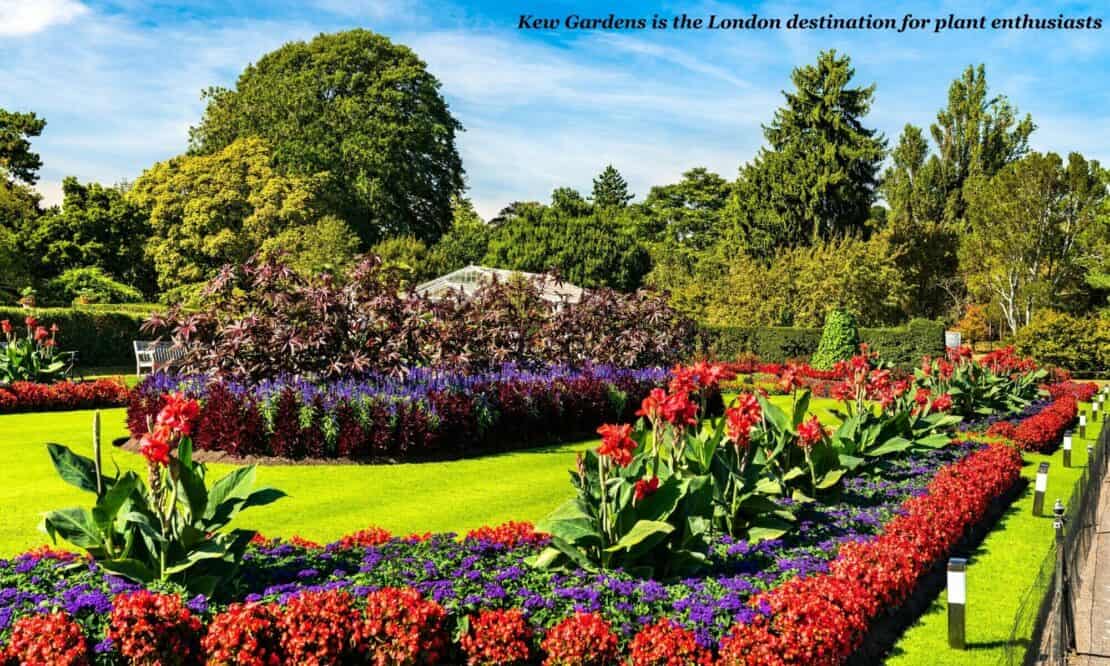
Kew Gardens
Kew Gardens, officially known as the Royal Botanic Gardens, is a horticultural jewel on the banks of the River Thames in southwest London.
Established in 1840, Kew Gardens spans 300 acres and is renowned for its diverse plant collections, historical significance, and scientific research initiatives. Home to the world’s most extensive collection of living plants, including rare and endangered species, Kew Gardens is a UNESCO World Heritage Site.
Within the grounds, the Palm House, Temperate House, and the Princess of Wales Conservatory, showcase a stunning array of plant life from around the globe. The Treetop Walkway offers visitors a unique perspective, providing panoramic views of the gardens.
Kew’s commitment to plant conservation and research is evident in its Millennium Seed Bank, a global repository safeguarding plant species for future generations. Beyond the plants, Kew Gardens hosts seasonal events, art exhibitions, and educational programs, making it one of London’s most interesting green places to see.
Famous Shops in London
Of course, one of of the things London is famous for is its shopping scene. The city dates back to Roman times and the trading has been going on ever since. In particular, these are the places that take you beyond the high street. From the famous department stores to the open air markets.
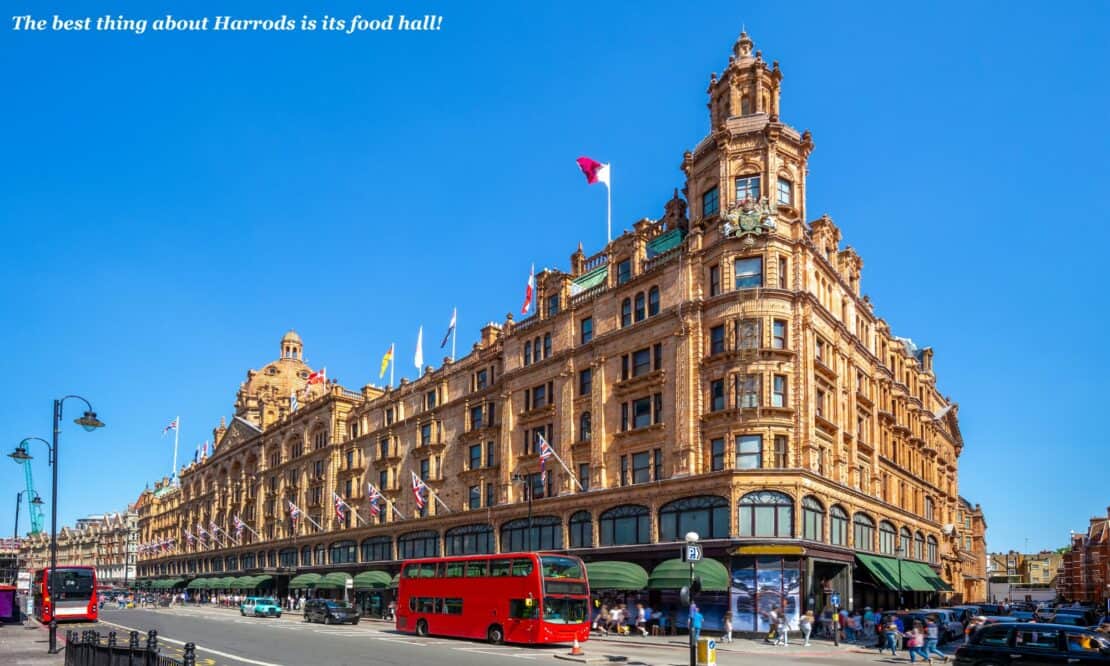
Harrods
Established in 1834 by Charles Henry Harrod as a humble grocery store, Harrods has evolved into a globally renowned department store, drawing visitors from around the world. The iconic green-and-gold façade welcomes shoppers to explore its seven floors, each housing a treasure trove of high-end fashion, exquisite jewellery, gourmet delicacies, and bespoke home goods. The Egyptian Hall, adorned with intricate hieroglyphics, adds a touch of historical grandeur to the shopping experience.
But the big draw remains the Food Halls, where pheasant eggs and caviar wait behind melt in your mouth chocolate.
Yet interestingly, it’s a popular place for rich and, well, not so rich alike. It’s free to look and some of the smaller samples are surprisingly affordable.
One of my favourite things to do in London is to head to Harrods to pick up a picnic before heading to nearby Hyde Park.
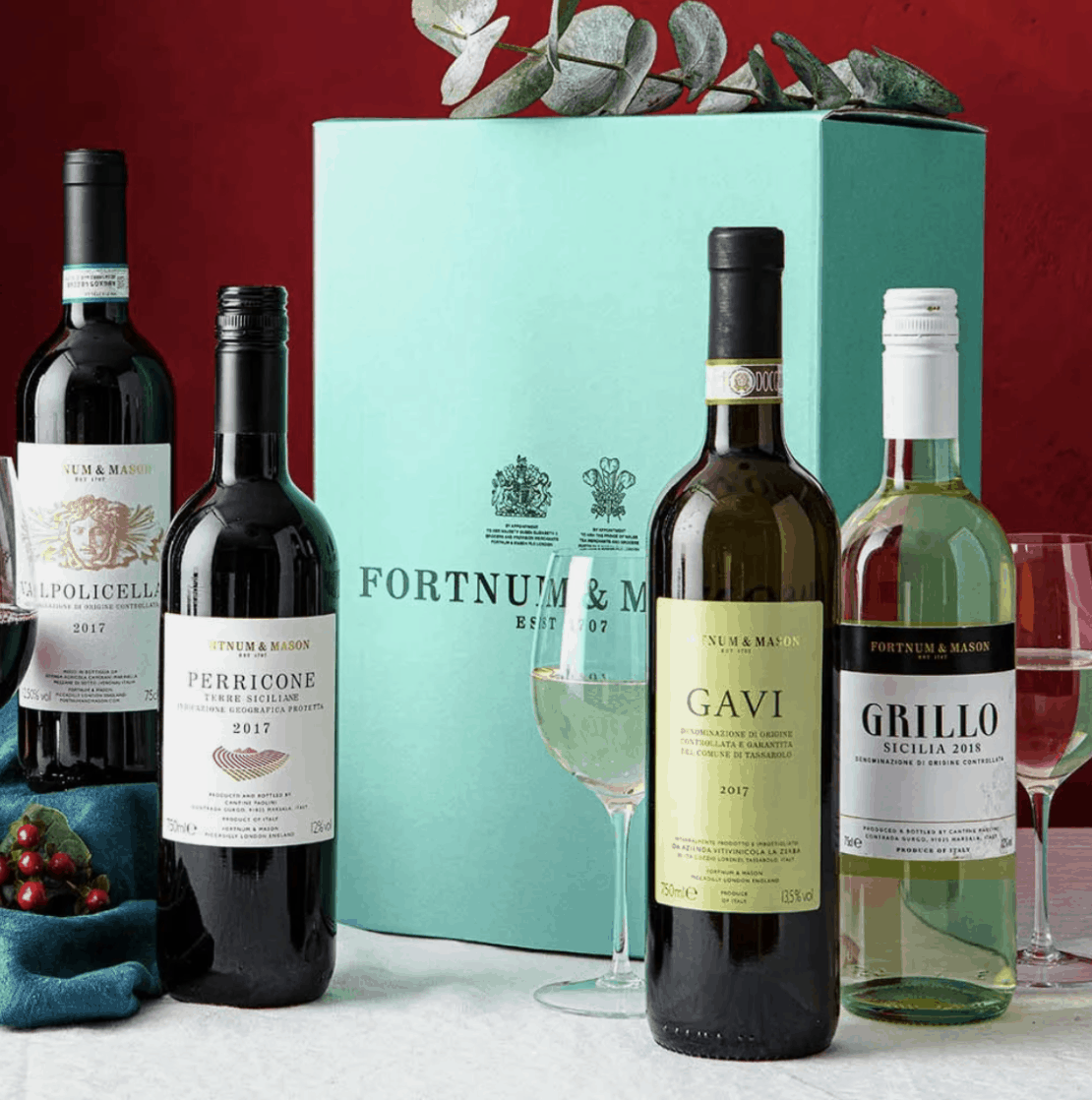
Fortnum & Mason
Fortnum & Mason, a distinguished purveyor of luxury goods, has graced London’s Piccadilly since its establishment in 1707, earning a reputation as a quintessential British institution. Founded by Hugh Mason and William Fortnum, it began as a small grocery store catering to the royal court.
Today, Fortnum & Mason is renowned for its commitment to quality, tradition, and an extensive array of exquisite products.
The Piccadilly store houses an opulent selection of teas, hampers, fine foods, and delicacies, with the Tea Salon on the fourth floor providing a refined setting for traditional afternoon tea.
Plus, it looks good. The building itself exudes charm with its classic façade and the clock that has overlooked the bustling street for over a century. Fortnum & Mason’s royal warrants, granted by the British monarchs, emphasise its historic role as a supplier to the royal household. The store’s seasonal offerings and events, including the renowned Christmas hampers and decorations, are one of those things London is known for by locals.
On any trip to London, I try to pop in to admire the displays, particularly around high days and holidays like Easter or Halloween.
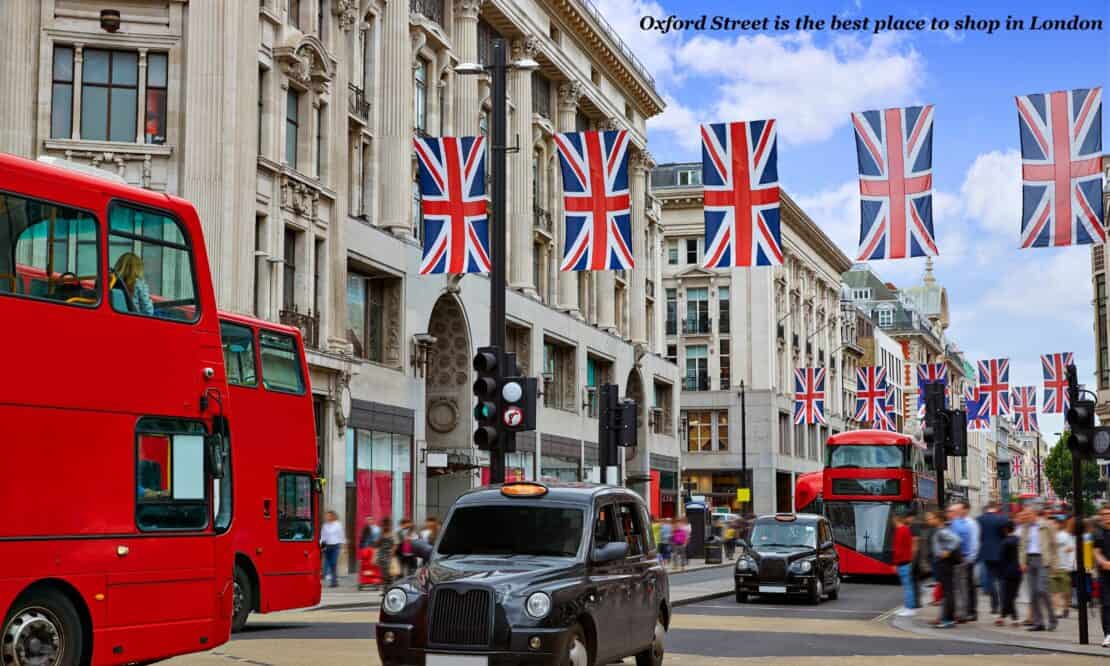
Oxford Street
What is London known for when it comes to shopping? Oxford Street. This is where most chains have their flagship department stores and, somewhat randomly, it’s a great place to see the Christmas Lights. However, if you ask me, it’s lost its lustre a bit over the years and the best places can be found away from this shopping street.
Timeless Things London is Famous For
London is also home to some really fun phrases and pieces of street furniture. Here’s what you can spot around London.
Red Buses
London’s iconic double-decker buses, with their bright red livery and open-platform design, have been a fixture on London’s streets for over a century. No matter how many times I visit London, I still find myself taking photos and videos of them as they lumber on by.
Black Cabs
Another transport feature people associate with London are the black cabs. One of the incredible things London is famous for is “the Knowledge,” a rigorous exam that all taxi drivers have to pass before they can be granted their license.
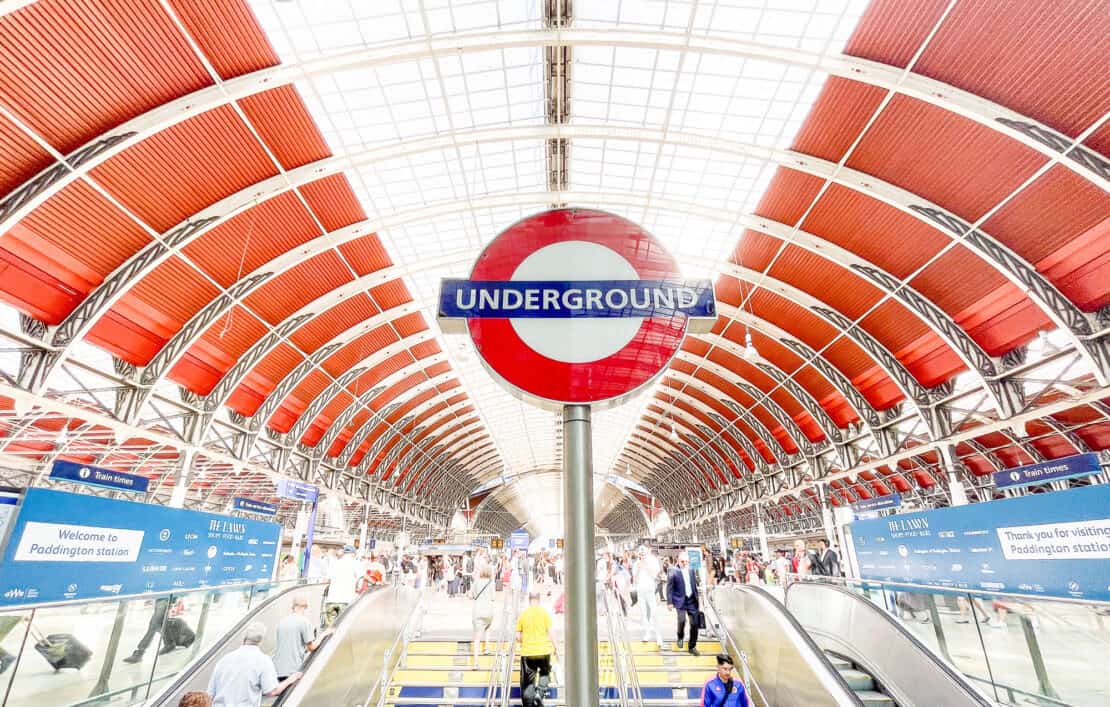
Mind the Gap
“Mind the Gap” has become an auditory emblem of London and it comes from the London Underground, also known as the Tube. Heard in stations across the vast network, the phrase serves as a cautionary reminder for passengers to be aware of the gap between the train and the platform as they embark or disembark.
Perhaps what makes it particularly British is the fact that the message actually includes the word please.
- Recommended reading: unusual things to do in London
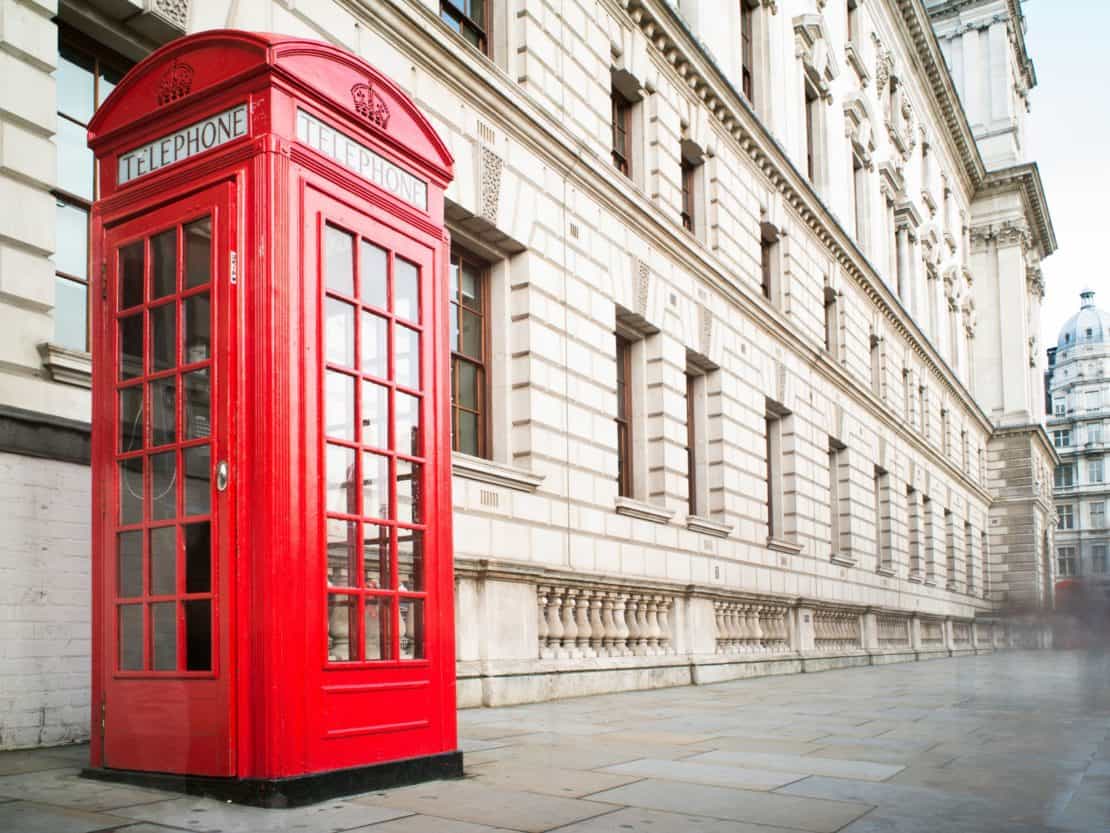
Red Phone Booths
The red phone booths, or telephone boxes, are another one of those cool things about London that stand out. Of course, they’re not only found in London, but across the UK, a bright bolt of nostalgia and a time gone by. Some of us are even old enough to remember when using them was the only way to get in touch with our parents… But anyway.
Introduced in the 1920s, many of them are now repurposed as mini-libraries, art installations, or even tiny coffee shops, showcasing their adaptability and enduring appeal.
Famous Food in London
The UK’s gastronomic scene is not widely celebrated around the world – but things have changed. Today, you can find dishes from any country in the world in London and at every price point. But when it comes to tradition, here are the dishes you need to try.
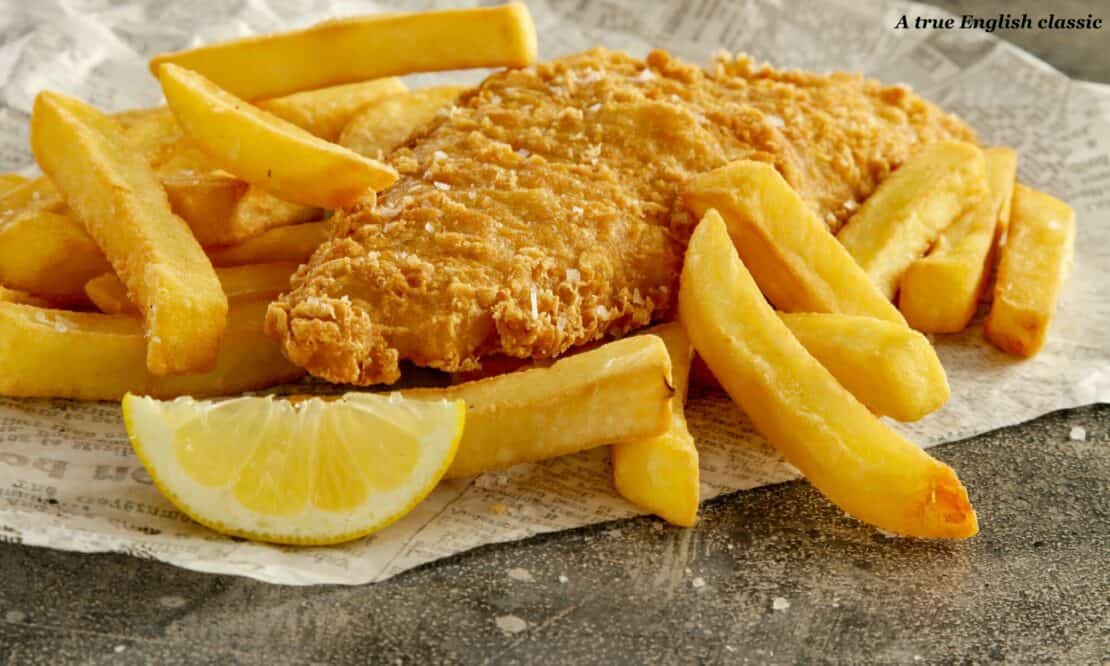
Fish and Chips
You’ll find this dish across the country, particularly at seaside resorts, but it’s common enough in London too. Fish, typically cod, comes fried in batter and served with chips. Traditionally, it comes wrapped in newspaper but these days you’re more likely to be handed a plain paper cone or, even more bizarrely, fake newspaper print.
Fish and chips are designed to be eaten outdoors, on the run, with perhaps a side of mushy peas and definitely a lot of salt, vinegar and ketchup.
Jellied Eels
Something of an acquired taste, jellied eels are the working man’s protein in East London and can often be found at the local chippy. I’ve never warmed to them but you may love them, so give them a go!
A Sunday Roast
Again, popular across the country, a Sunday roast is a traditional part of the week. The roast itself can mean beef, pork or chicken, served with several vegetables, roast potatoes, gravy and one last important thing. The Yorkshire pudding. This cup shaped savoury staple is surely the best part of the meal.
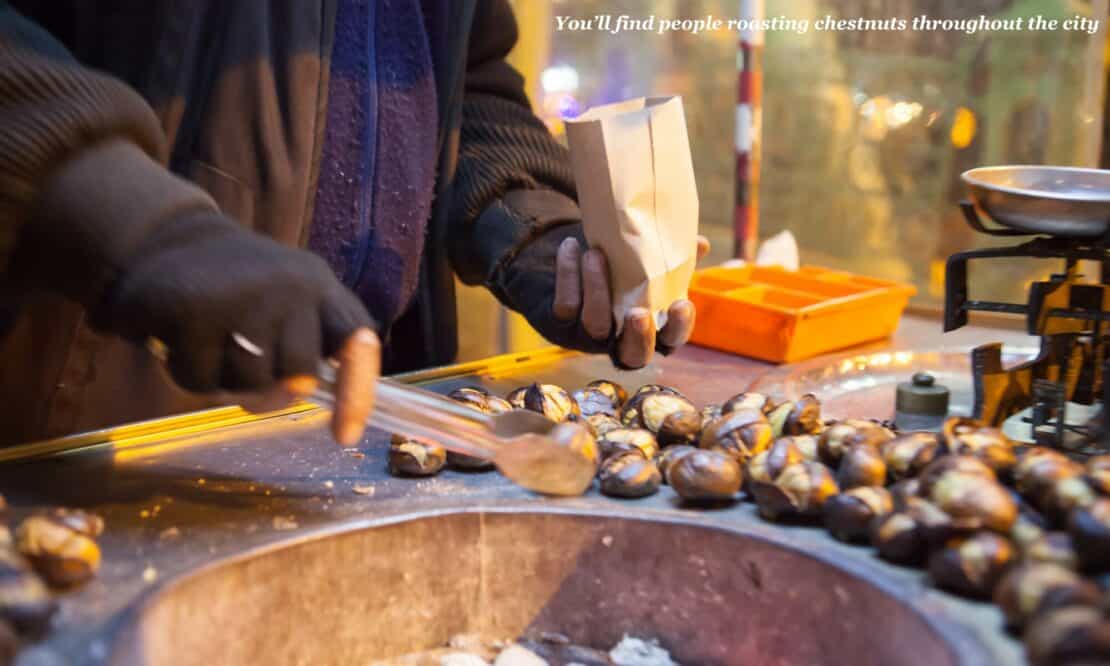
Roast Chestnuts
Roast chestnuts, a winter delicacy, add a warm and festive touch to the streets of London, particularly during the colder months. The tradition of roasting chestnuts on open fires has been a part of British culture for centuries, so it’s a real link to the past. Look out for street vendors, especially in popular areas like Covent Garden, Southbank, and Oxford Street, where they set up stalls with mobile roasters.
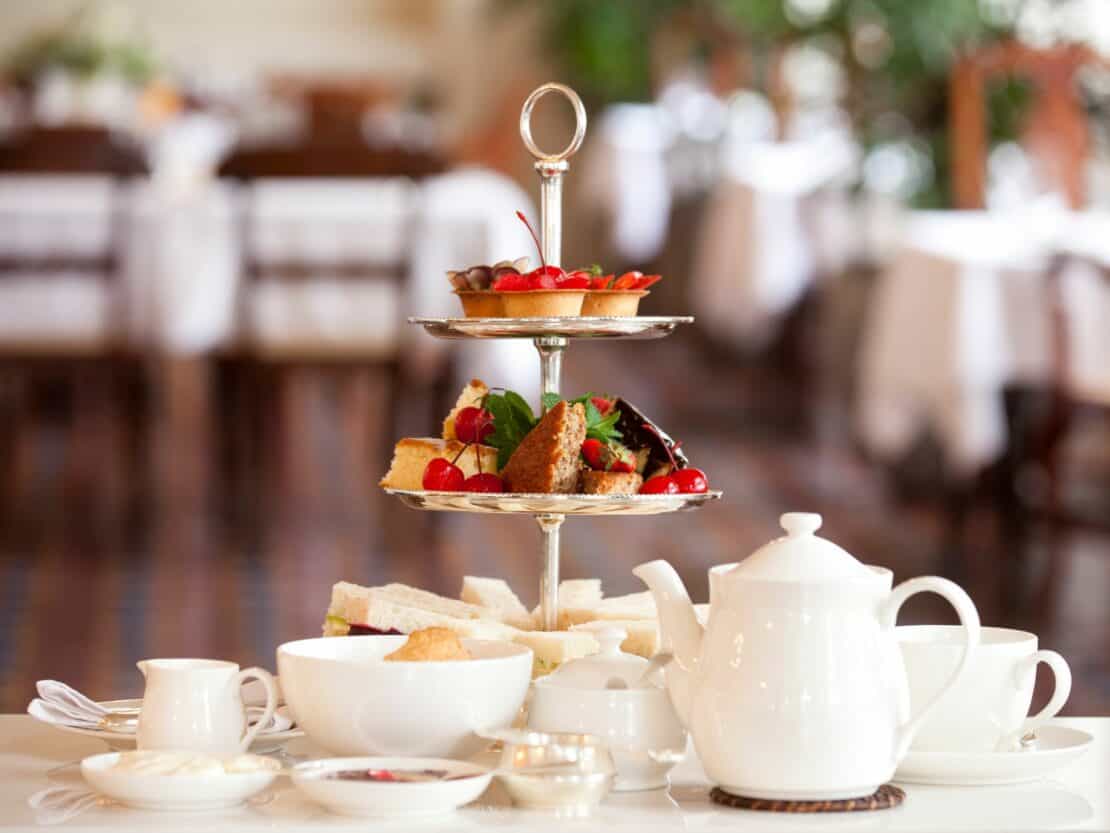
Afternoon Tea
Afternoon tea in London is a cultural institution that epitomizes elegance, tradition, and indulgence. Unlike everything else we’ve talked about so far, this isn’t a weekly thing. It’s reserved for very special occasions.
Dating back to the 19th century, afternoon tea is credited to Anna, the Duchess of Bedford, who started the practice of having a light meal with tea to stave off hunger between lunch and dinner.
Today, classic venues such as The Ritz, Claridge’s, and The Savoy have become synonymous with luxurious afternoon tea experiences, where tiered trays showcase delicate finger sandwiches, scones with clotted cream and jam, and an assortment of decadent pastries and cakes. The refined setting, often accompanied by live piano music, fine china, and impeccable service, transforms afternoon tea into a celebration of sophistication.
Famous Museums in London
London museums are great places to visit on a rainy day. And since there are a lot of rainy days in the UK, so will find many museums. There’s so much to see but let’s start with the highlights…
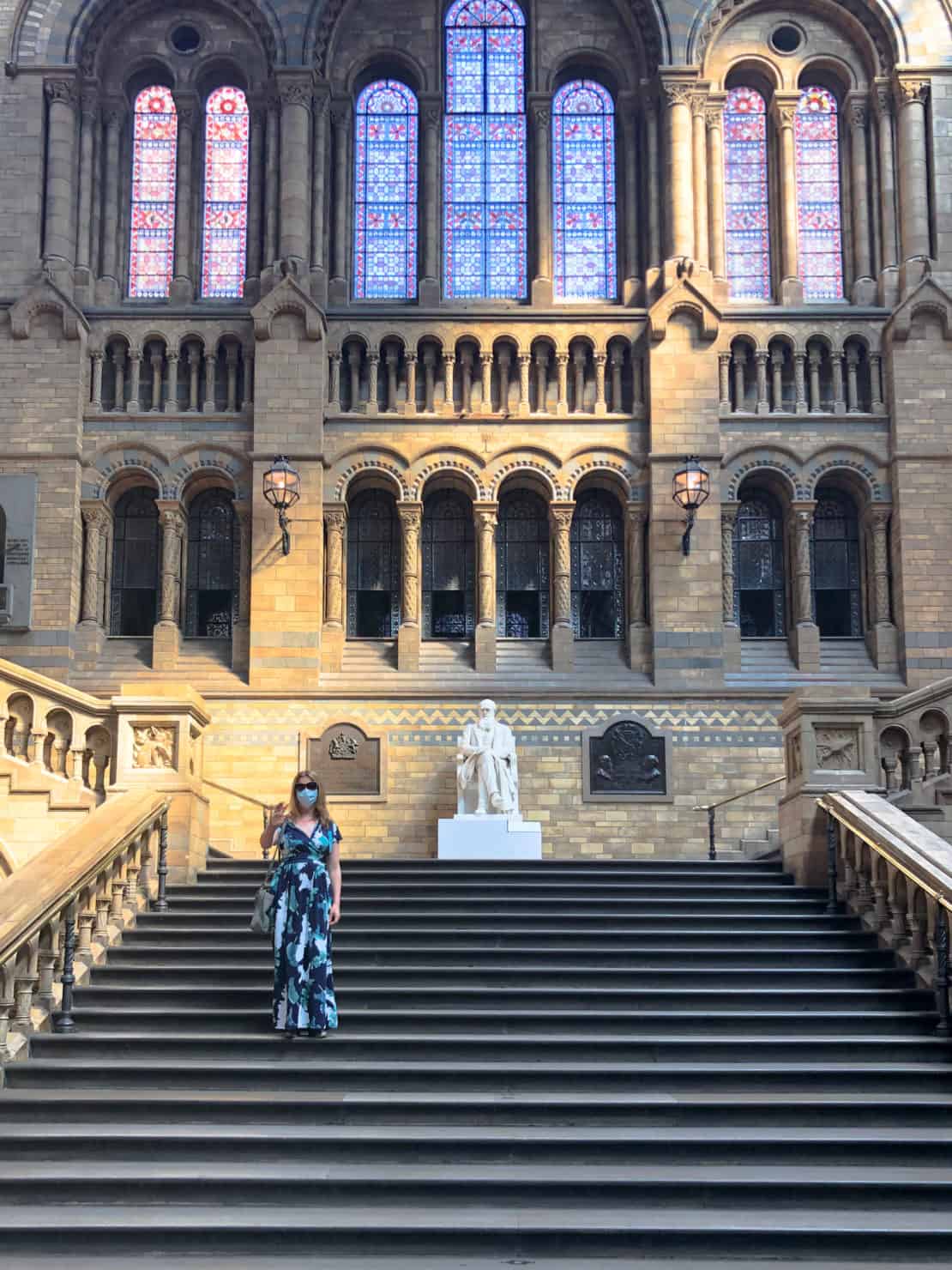
The Natural History Museum
The Natural History Museum in London is less a museum and more a stunning cathedral of science and exploration.
Established in 1881, the museum’s imposing Romanesque architecture and intricate terracotta ornamentation make it a landmark in South Kensington. The grand Hintze Hall welcomes visitors with a towering blue whale skeleton, and beyond that you’ll find over 80 million specimens, including dinosaur fossils, gemstones, and rare minerals. The interactive exhibitions, such as the Earth Galleries and the Darwin Centre, engage visitors of all ages. And best of all? Entrance is completely free.
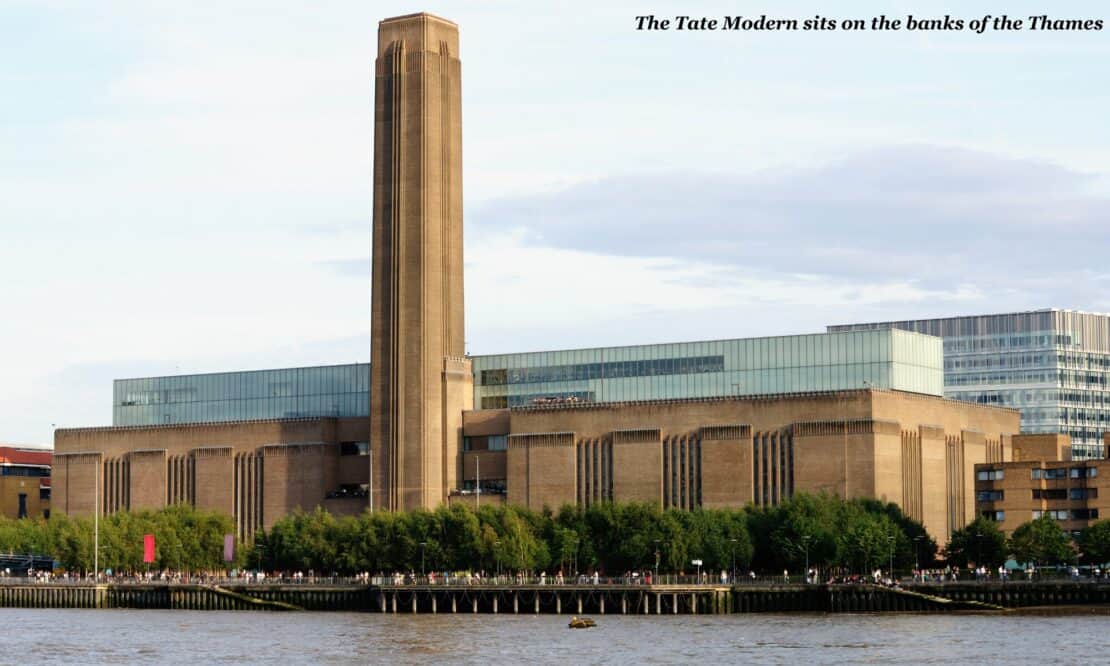
The Tate & Tate Modern
Dating back to 1897, the Tate comprises four major galleries: Tate Britain, Tate Modern, Tate Liverpool, and Tate St Ives. Tate Modern, housed in a former power station on the banks of the River Thames, stands as a global powerhouse for contemporary art, featuring works by renowned artists such as Picasso, Warhol, and Hockney. Tate Britain, situated in Millbank, showcases a rich collection of British art from the 16th century to the present day, while Tate Liverpool and Tate St Ives focus on regional and international contemporary art (although, clearly, these last two are not found in London.
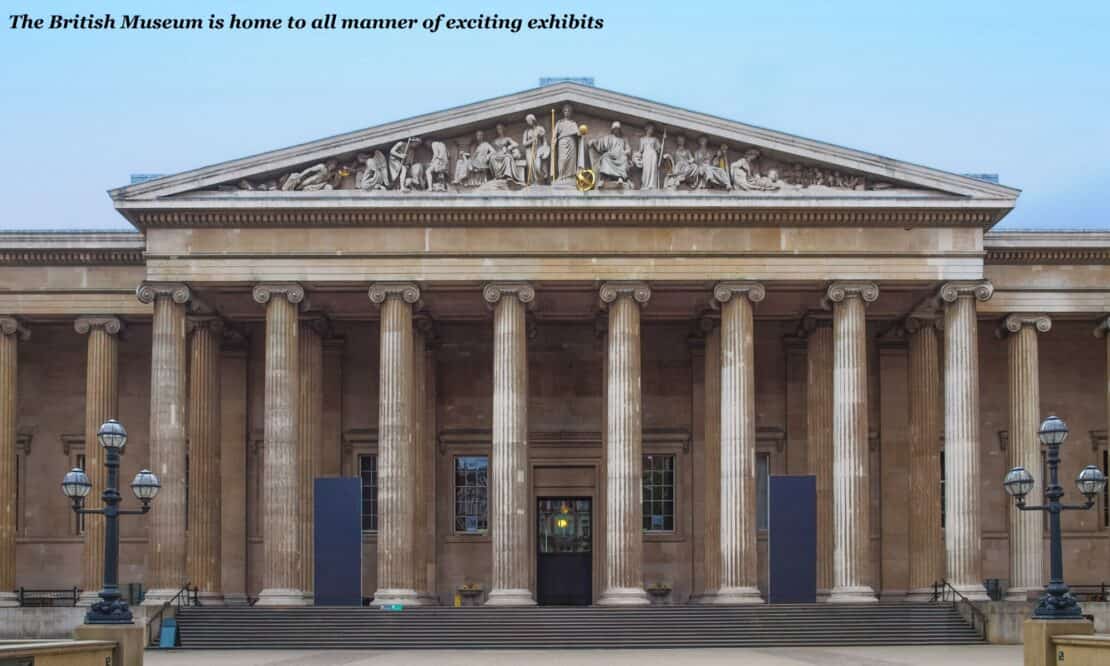
The British Museum
The British Museum has a dull sounding name but contains an extraordinarily exciting collection of exhibits.
Its vast and diverse collection spans over two million years of human history, featuring artefacts from virtually every corner of the globe. The Rosetta Stone and Egyptian mummies live here but so, too, do original manuscripts from Shakespeare, Austen and the Beatles.
Famous Events in London
When a man is tired of London, he is tired of life because there is always something to do and things to see.
Here are the traditional highlights on the calendar…
The Boat Race
The Boat Race, an annual rowing competition between the University of Oxford and the University of Cambridge, has become a quintessential fixture in London’s sporting and social calendar. Dating back to 1829, the race takes place on the River Thames and covers a historic stretch between Putney and Mortlake. The event typically occurs in the spring, drawing thousands of spectators who line the riverbanks and bridges to cheer for their respective teams. The crews, comprised of elite rowers, battle it out in an intense and grueling race, showcasing not only physical prowess but also the fierce rivalry between the two prestigious universities.
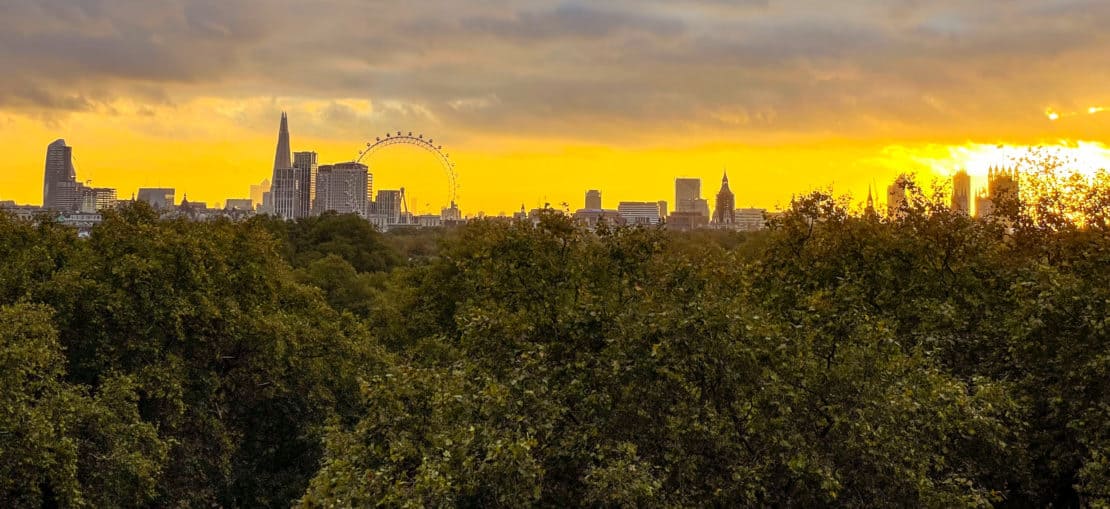
Bonfire Night
Bonfire Night, also known as Guy Fawkes Night, is a spirited tradition that takes place throughout the city. Originating from the failed Gunpowder Plot of 1605, where Guy Fawkes attempted to blow up the Houses of Parliament, the event is marked on the 5th of November each year.
Bonfires are lit, and fireworks illuminate the night sky, somewhat bizarrely symbolising the thwarting of the plot and celebrating the preservation of the monarchy. Londoners gather in parks and open spaces to enjoy dazzling firework displays, often accompanied by traditional foods like toffee apples and bonfire toffees. Effigies of Guy Fawkes are burned on bonfires, and the event is marked by the communal spirit of sharing warmth in the autumnal chill via the means of a hot baked potato wrapped in foil. If that sounds like your cup of tea, you can find out more about the best things to do in Autumn in London here.
The Lord Mayor’s Show
The Lord Mayor’s Show, a grand and centuries-old tradition, dates back to the 13th century and celebrates the appointment of the Lord Mayor of the City of London. The show typically takes place in November and unfolds with a procession that winds its way through the historic streets of the City. The newly elected Lord Mayor, resplendent in traditional regalia, travels in a gilded state coach, accompanied by an eclectic mix of floats, marching bands, and colourful performances.
London Fashion Week
London Fashion Week (LFW) is a dynamic and globally influential event that always leaves me feeling rather underdressed.
Established in 1984, LFW has evolved into one of the “Big Four” international fashion weeks, alongside New York, Milan, and Paris. Held biannually, LFW attracts designers, industry professionals, celebrities, and fashion enthusiasts from around the world. The event serves as a platform for both emerging and established designers to unveil their latest collections, pushing boundaries and setting trends. Venues such as Somerset House and The Store Studios have hosted runway shows, presentations, and immersive fashion experiences during the week-long event. London’s reputation for nurturing creativity and embracing innovation is reflected in the eclectic mix of styles, ranging from avant-garde and experimental to classic and timeless.
Famous Neighbourhoods in London
London is a city of neighbourhoods and these are some of the most fun for new visitors.
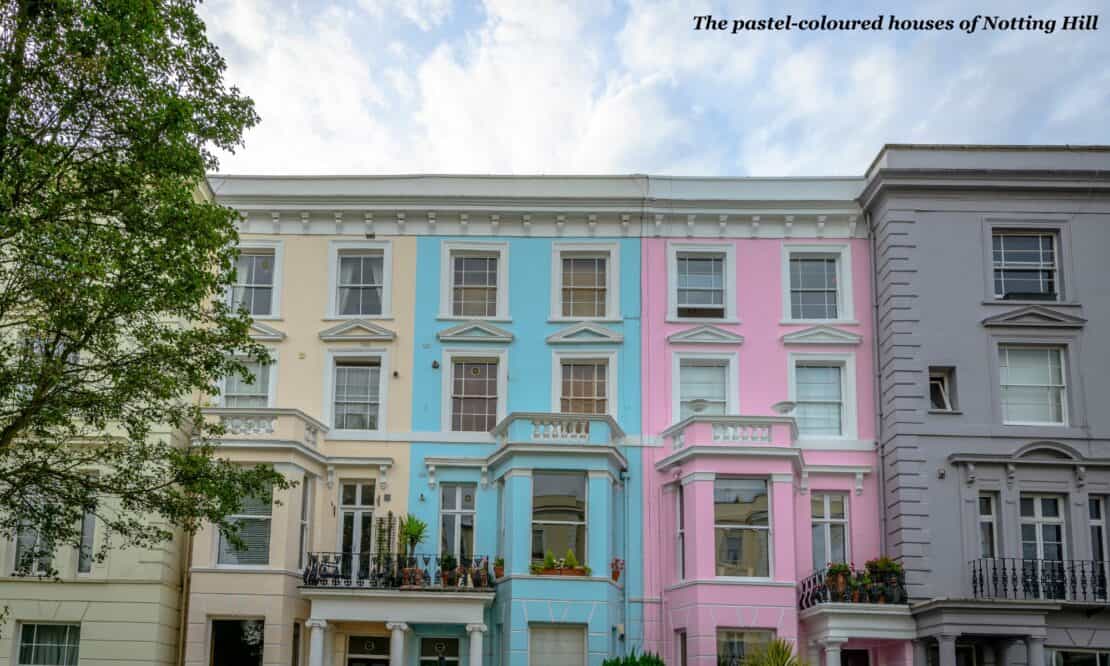
Notting Hill
Notting Hill in West London, is known for its picturesque streets lined with pastel-colored houses, trendy boutiques, and bustling markets. Oh, and that Hugh Grant film, too.
The neighbourhood has evolved from its Victorian roots into a dynamic and sought-after area. Portobello Road Market, one of the world’s largest antique markets, is a focal point, offering a kaleidoscope of vintage finds, artisanal goods, and international cuisine. The annual Notting Hill Carnival, Europe’s largest street festival, brings the neighbourhood alive with vibrant parades, music, and Caribbean-inspired festivities.
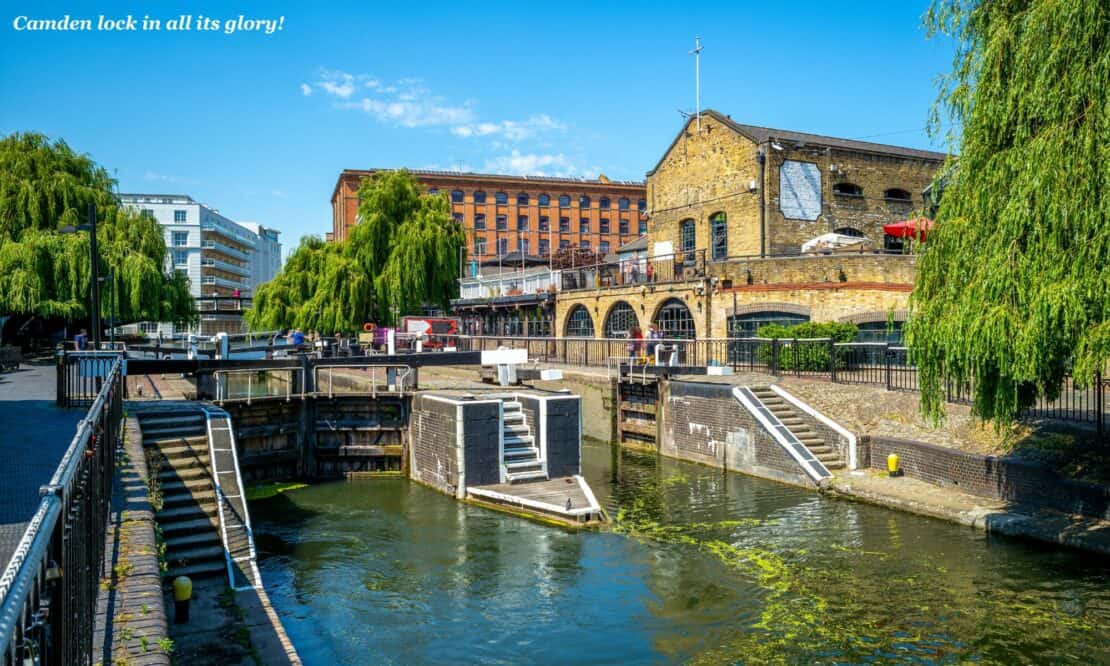
Camden
Camden, a dynamic and eclectic neighbourhood in North London, is a kaleidoscope of alternative culture, music, and artistic expression. Once a hub for industry and commerce along the Regent’s Canal, Camden has transformed into a bohemian enclave known for its unique character.
Camden Market, which includes the Stables Market and Camden Lock Market, draws locals and tourists alike with its eclectic mix of stalls selling vintage clothing, handmade crafts, and international cuisine. Street performers, live music, and the charming canalside setting provide a lively atmosphere.
Shoreditch
Another cool area in London is Shoreditch. This East London neighbourhood, has evolved from its industrial roots into a trendy and vibrant hub for creativity, innovation, and a distinct urban culture. The neighbourhood’s brick warehouses and Victorian architecture provide a backdrop for its eclectic street art scene. Walls adorned with colorful murals and graffiti reflect the area’s artistic spirit, with the Shoreditch Street Art Tours providing insight into the ever-changing canvas.
Shoreditch’s renowned Brick Lane is a culinary melting pot, offering a diverse range of international cuisines, vintage shops, and quirky galleries. The Old Truman Brewery, once a historic brewery, has transformed into a cultural and creative space, hosting markets, events, and exhibitions.
The tech and startup scene flourishes in Shoreditch, with Silicon Roundabout at Old Street being a focal point for innovation and entrepreneurship. Co-working spaces, trendy cafes, and networking events contribute to the neighbourhood’s reputation as a hub for tech professionals and creatives. Although, I’ve worked there for a while so perhaps it’s not that cool after all.
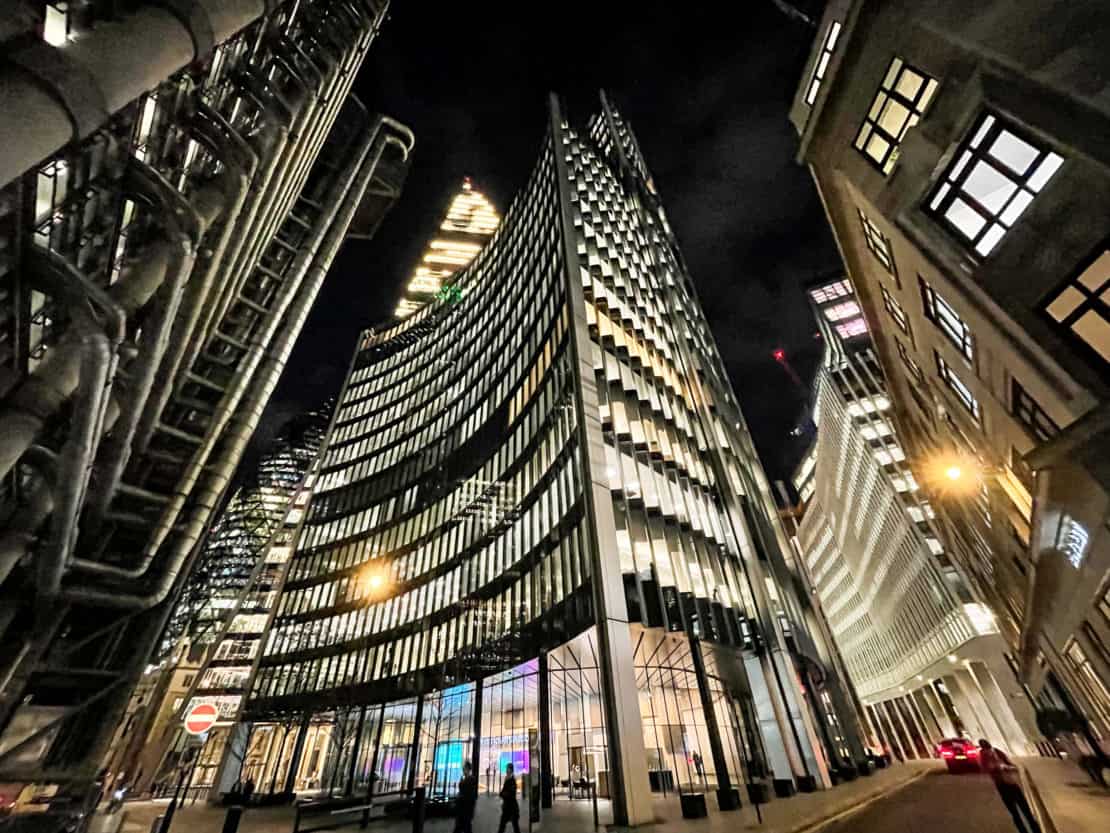
The Square Mile
The Square Mile, also known as the City of London, is a historic and bustling district that serves as the beating heart of London’s financial and commercial prowess. It’s home to iconic landmarks such as St. Paul’s Cathedral, the Bank of England, and the Lloyd’s Building.
As the oldest part of London, the Square Mile’s narrow streets are a labyrinth of ancient alleyways juxtaposed with towering skyscrapers, an astonishing juxtaposition of old and new.
It’s a lively place to visit by day but can feel rather empty and soulless by night, so I wouldn’t recommend staying in a hotel here.
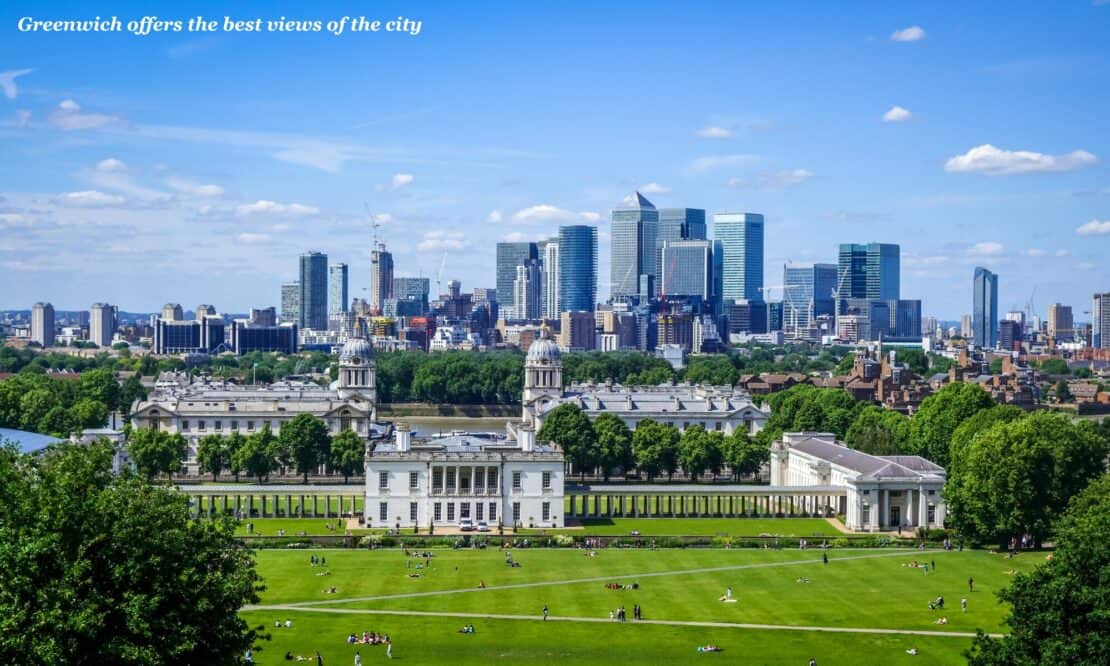
Greenwich
Greenwich, a picturesque and historic neighbourhood in Southeast London, is a charming spot and one of my favourite London experiences. It’s also a UNESCO World Heritage Site to boot.
The Royal Observatory, perched atop Greenwich Hill, is where the world’s Prime Meridian is marked, making it the reference point for Greenwich Mean Time (GMT). You can stand on both the eastern and western hemispheres simultaneously, a popular tourist pastime which turns out to be surprisingly fun.
Greenwich’s maritime legacy is encapsulated in the historic Cutty Sark, a 19th-century tea clipper turned museum, and the National Maritime Museum, which houses an extensive collection of maritime artifacts. The Greenwich Naval College, with its stunning Painted Hall and Chapel, adds to the neighbourhood’s regal vibe.
Greenwich Market is fun, with a mix of food stalls, artisanal crafts, and antiques and the Thames Path offers scenic riverside walks.
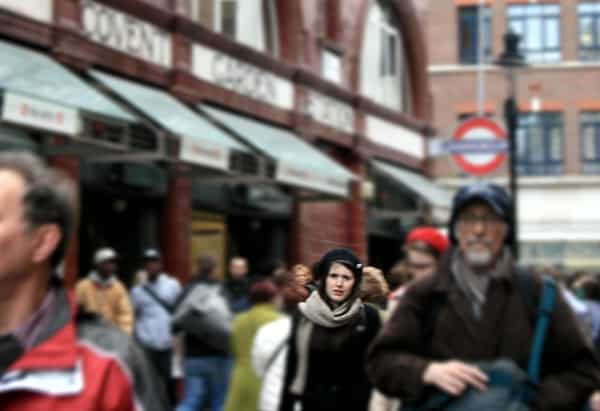
Covent Garden
Originally a fruit and vegetable market that dates back to the 17th century, Covent Garden today is best known for its street performances, market, and sense of fun.
The centrepiece of Covent Garden is the Market Building, adorned with its distinctive glass roof and surrounded by cobblestone streets. Then there’s the Royal Opera House, a world-renowned venue for opera and ballet and Neal’s Yard is a hidden courtyard with quirky shops and health food stores.
In short, it’s a fun place to be and I dare you to visit and leave feeling bored.
Leicester Square
Situated in the heart of London’s West End, Leicester Square is the premier destination for red-carpet events, and blockbuster movie screenings. By day, I do find it can seem a little underwhelming but by night, with the stars shining, it’s glam and glitz all the way.
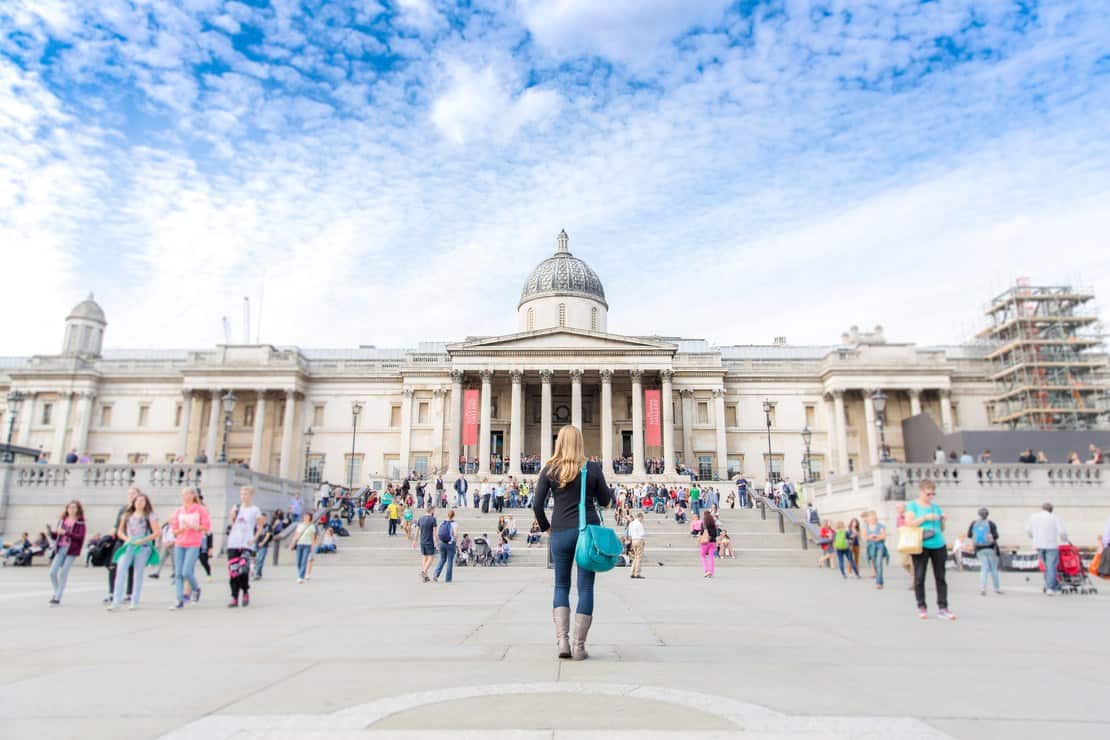
Trafalgar Square
Named in honour of the British naval victory at the Battle of Trafalgar in 1805, the square has served as a focal point for cultural events, celebrations, and gatherings for centuries. Dominated by Nelson’s Column, a monument commemorating Admiral Lord Nelson, the square exudes a stately elegance. The National Gallery, occupying the square’s northern side, showcases an exceptional collection of European paintings from the 13th to the 19th centuries.
The plinths around the square feature various sculptures, including the loyal lions and the ever-changing Fourth Plinth contemporary art installations.
It’s a fun place to meet and get a sense of London’s energy.
Chelsea
Chelsea, an affluent and sought-after neighbourhood in Southwest London, is synonymous with elegance and exclusivity. Renowned for its upscale residences and stylish boutiques, it is one of the hotspots for the young, rich and famous.
The Saatchi Gallery, located in the Duke of York’s Headquarters, is a contemporary art space and core part of Chelsea’s cultural scene. The gallery showcases innovative and thought-provoking exhibitions, reflecting the neighbourhood’s commitment to the arts.
Then there’s Sloane Square and Cadogan Square, surrounded by grand Georgian and Victorian residences.
The Royal Hospital Chelsea, home to the famous Chelsea Pensioners, is an unmistakeable spot and the annual Chelsea Flower Show, hosted in the Royal Hospital Gardens, is a world-renowned event.
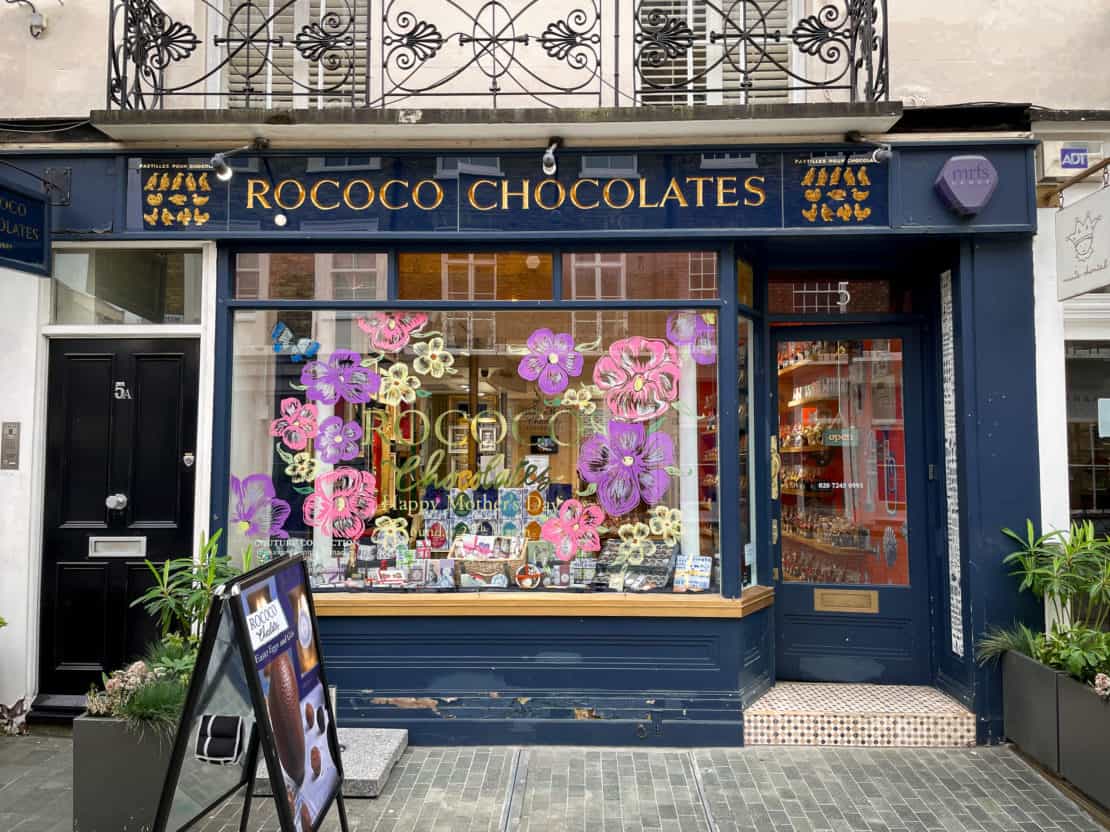
Belgravia
Belgravia, an affluent district in the heart of London, epitomizes elegance, opulence, and timeless charm. Situated southwest of Buckingham Palace, Belgravia is renowned for its grand Regency architecture, pristine garden squares, and upscale residences. Developed in the 19th century by the Grosvenor family, the area exudes a sense of exclusivity and sophistication.
The Belgrave Square and Eaton Square, with their manicured gardens, stand as prime examples of the neighbourhood’s green spaces. The trademark white stucco-fronted houses, often adorned with intricate wrought-iron balconies and regal facades, contribute to the district’s aesthetic and the certain London look.
Belgravia is not just a residential enclave; it’s also home to high-end boutiques, Michelin-starred restaurants, and luxurious hotels. Check out our guide to the best things to do in Belgravia for more inspiration.
Famous Characters in London
London is one of those places where even the fictional characters become famous. Here are some of the legends you’ll find around the city.
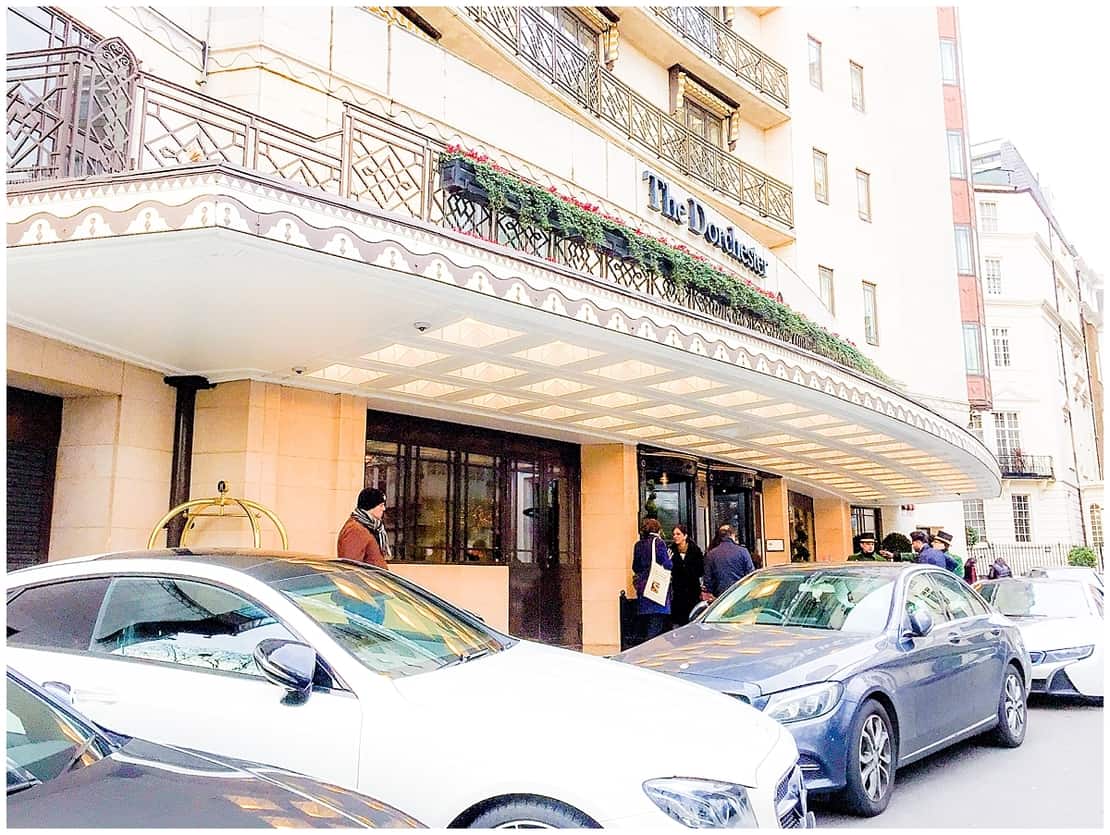
James Bond
James Bond, the British secret agent created by author Ian Fleming, has become synonymous with London, adding a touch of glamorous espionage to the city’s cultural identity. From the MI6 headquarters at Vauxhall Cross to the elegant casinos and upscale hotels, such as The Dorchester, Bond navigates the city’s landmarks with a cool demeanour.
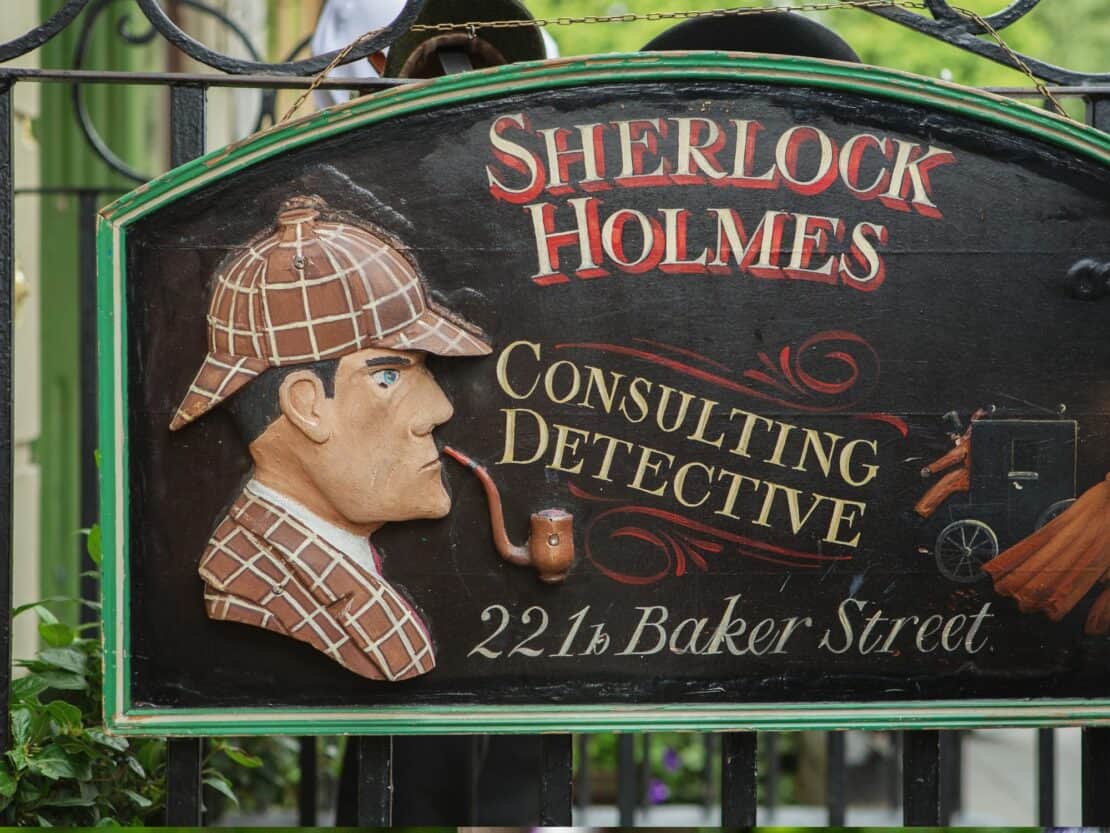
Sherlock Holmes
Sherlock Holmes, the brilliant detective created by Sir Arthur Conan Doyle, is inseparable from the fog-laden streets and Victorian dream of London.
221B Baker Street, Holmes’ fictional residence, has become an prime London landmark, and while the actual address doesn’t quite exist, you’ll find a whole load of Sherlock Holmes memorabilia in and around Baker Street.
Paddington Bear
Then there’s Paddington Bear, the lovable fictional character created by Michael Bond.
Paddington, a polite and endearing bear from Peru, arrives at Paddington Station with a tag that reads “Please Look After This Bear,” setting the stage for his heartwarming adventures in the British capital. Paddington Station, where he was first discovered by the Brown family, becomes a central location in the stories and you’ll find plenty of Paddington souvenirs here in real life too.
More About Travel in London
- 101 great ideas for autumn in London
- The best things to do in Belgravia, London’s most refined neighbourhood
- How to spend 72 hours in London: your perfect London itinerary
- The best things to do in Kingston upon Thames in London
- 31 Unusual things to do in London
- 15 interesting nicknames for London and what they mean

